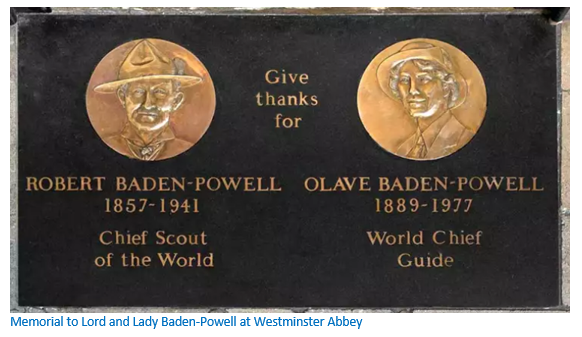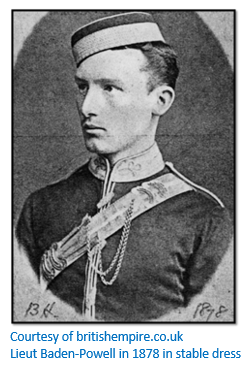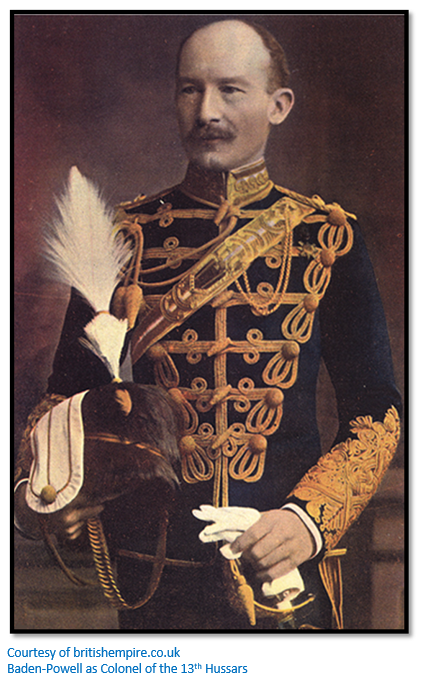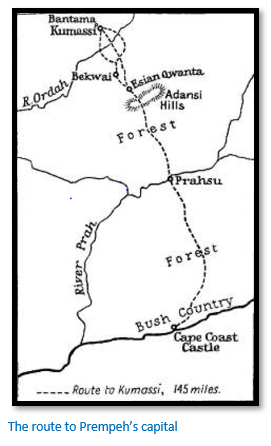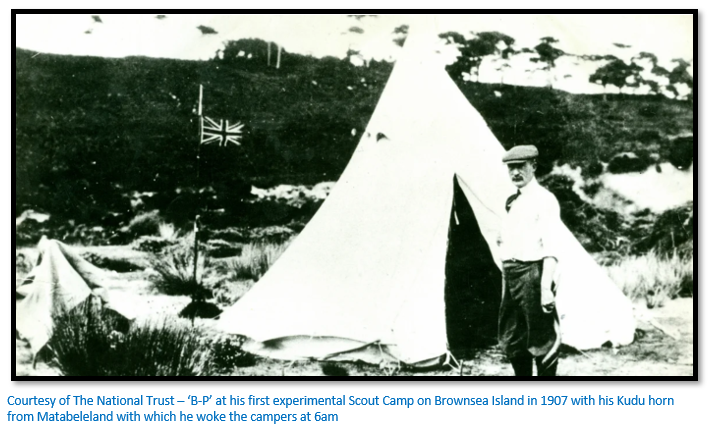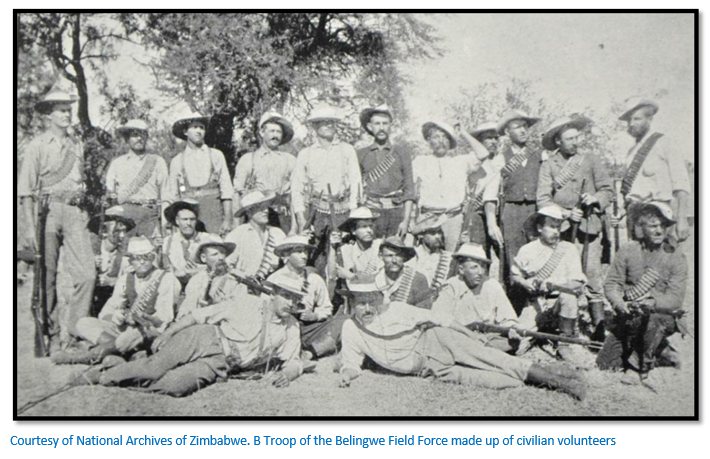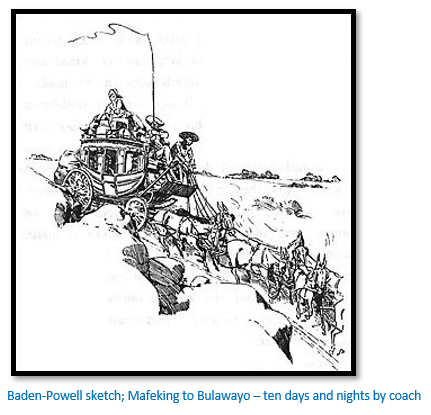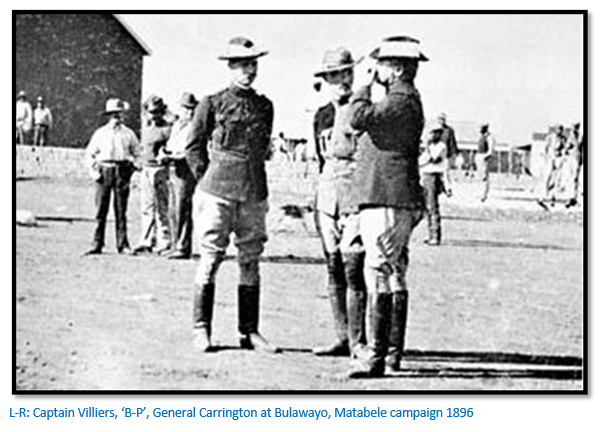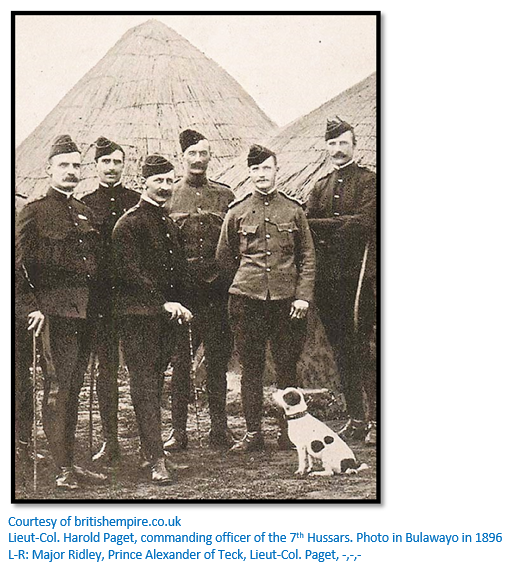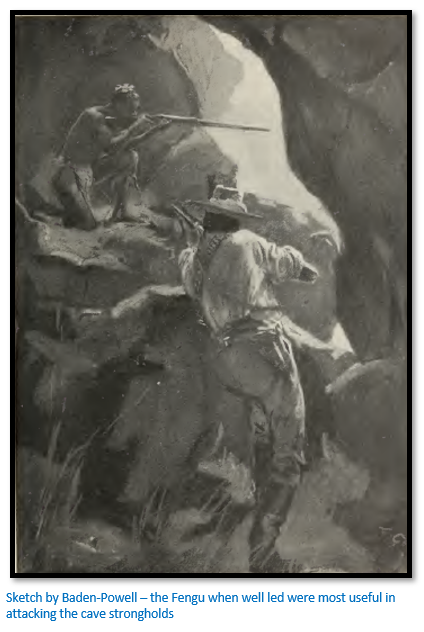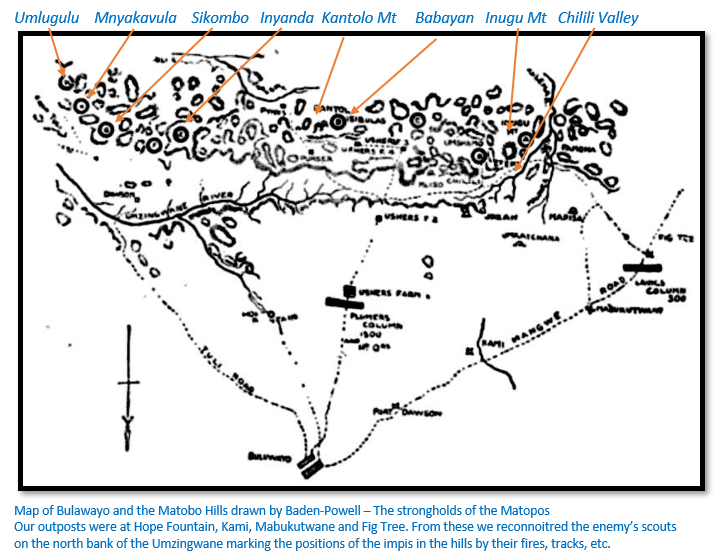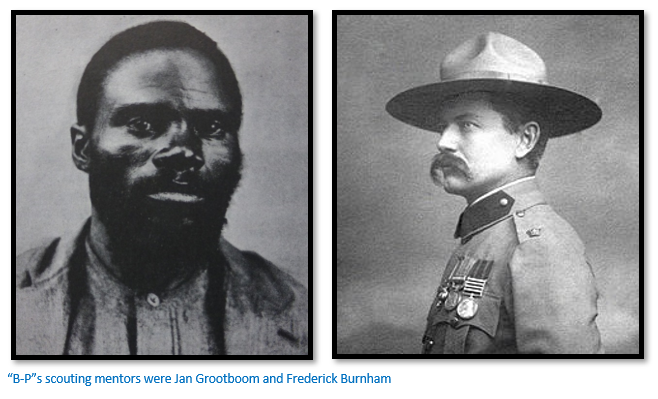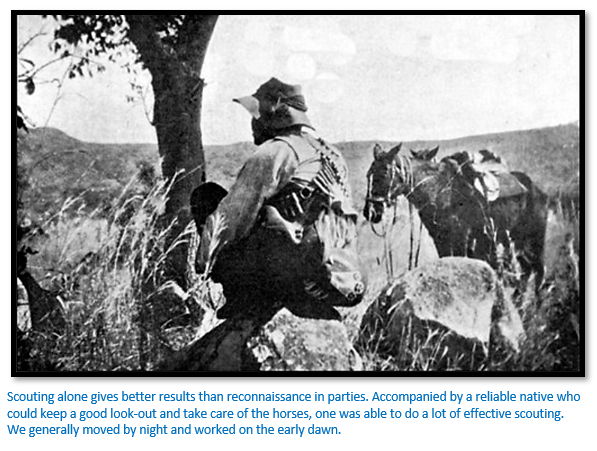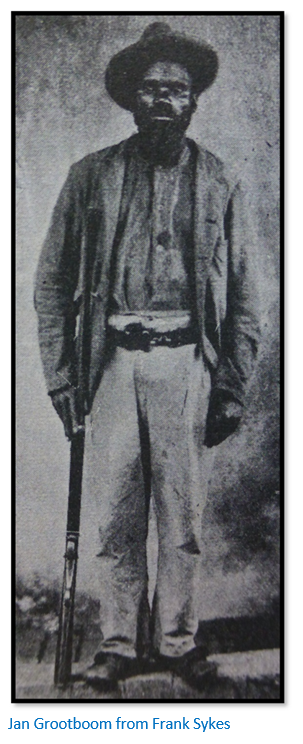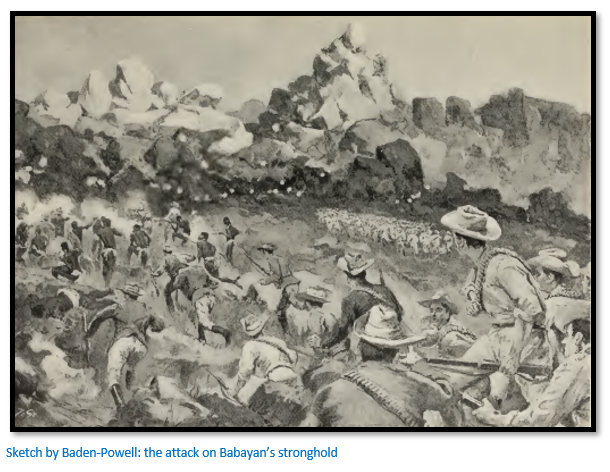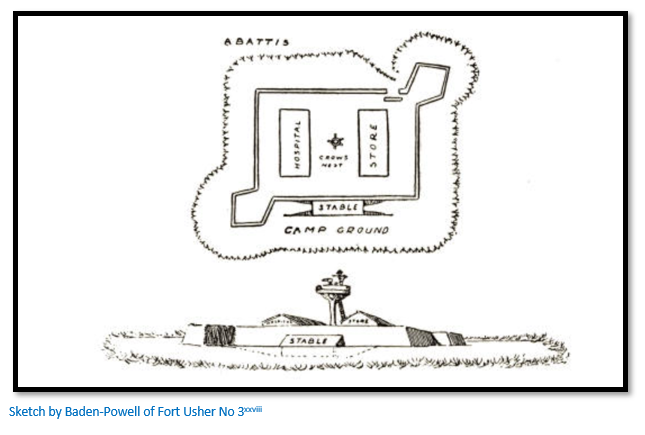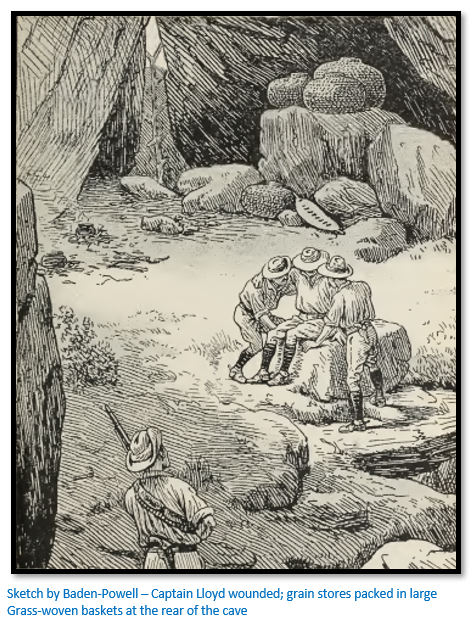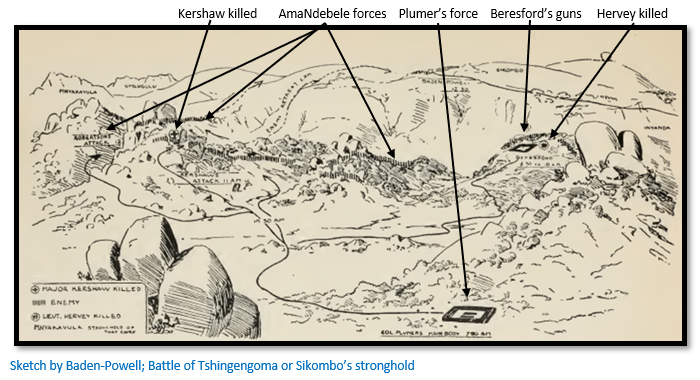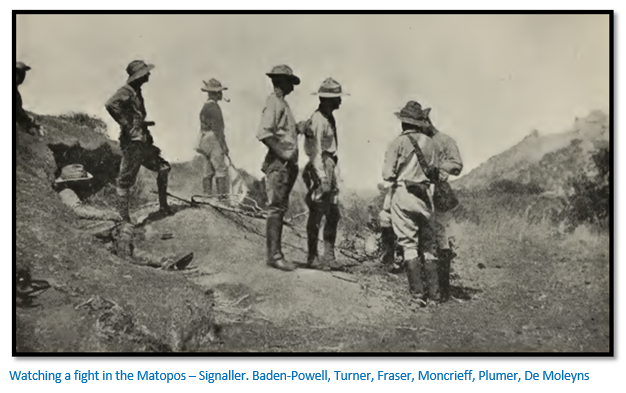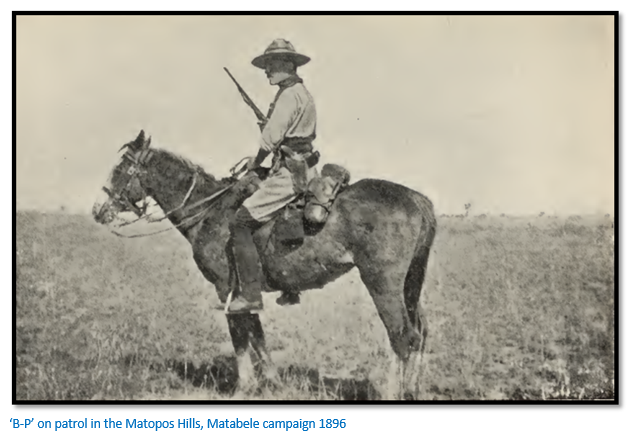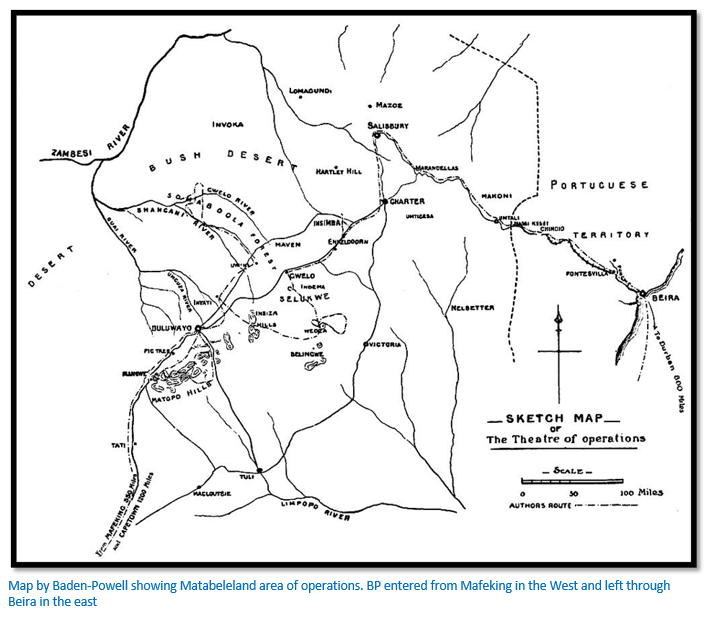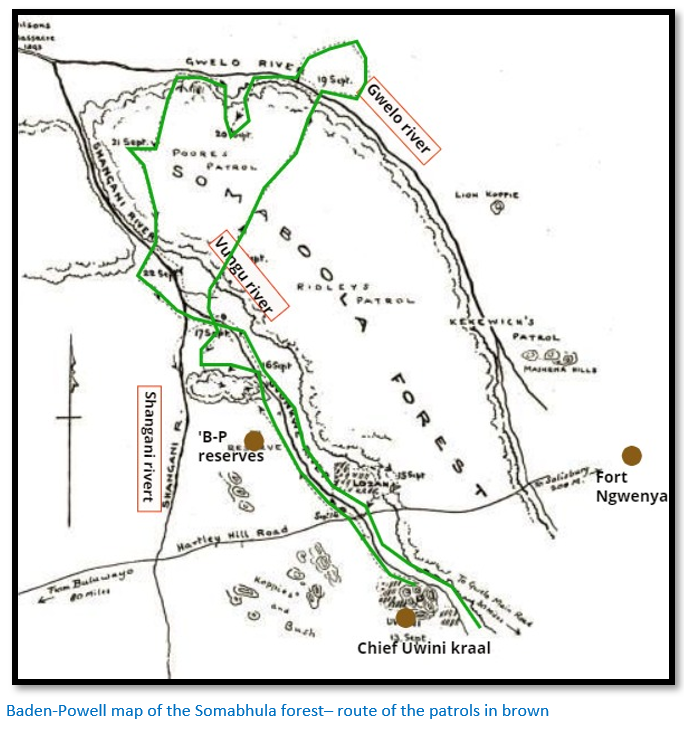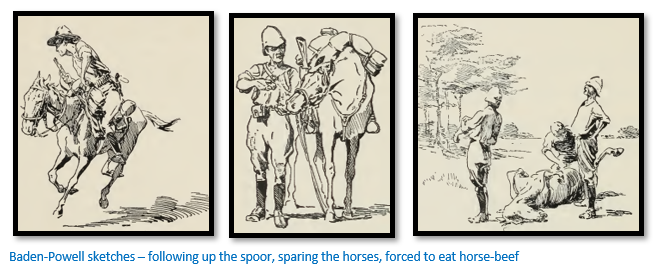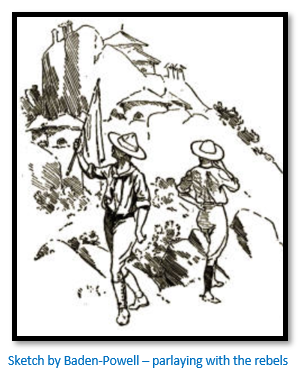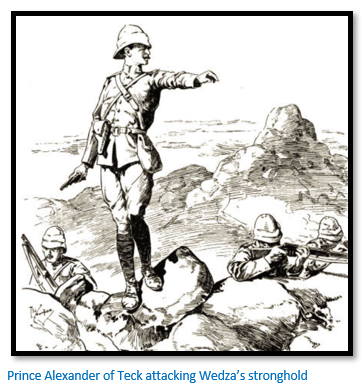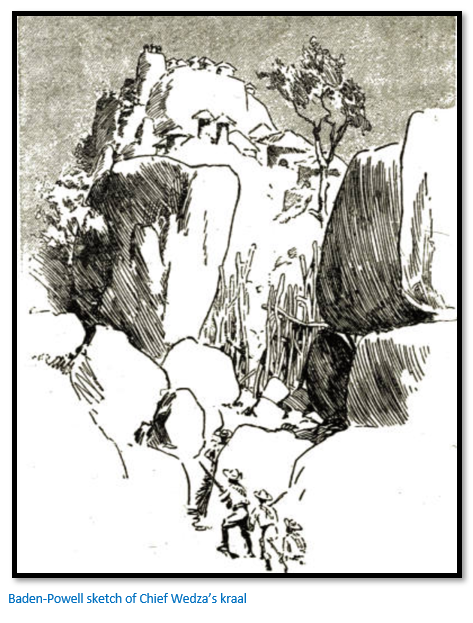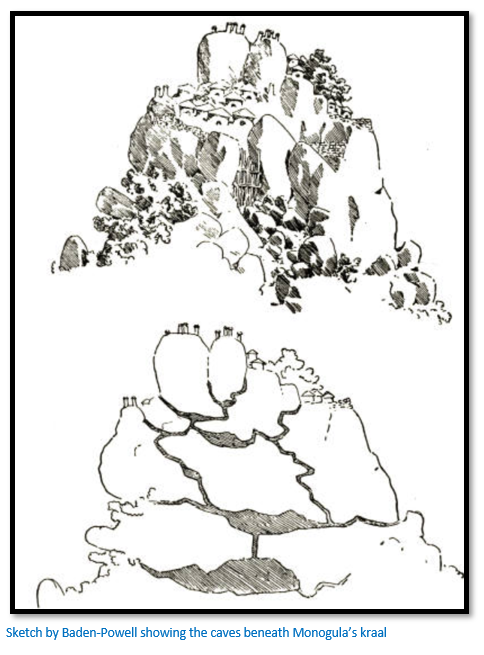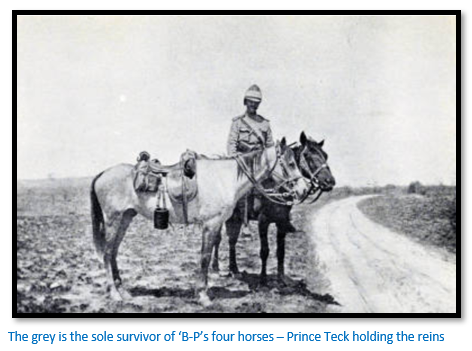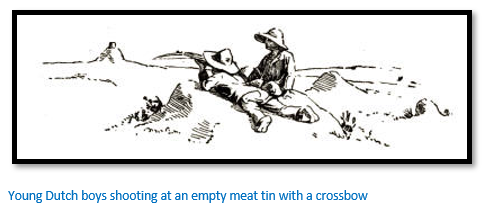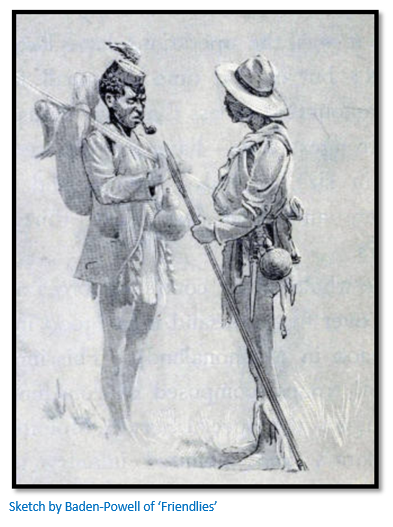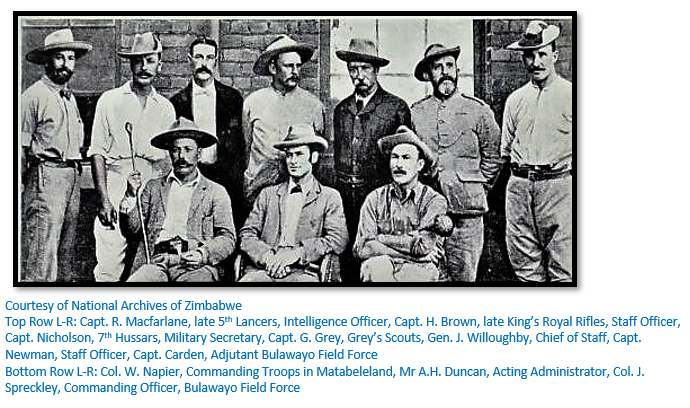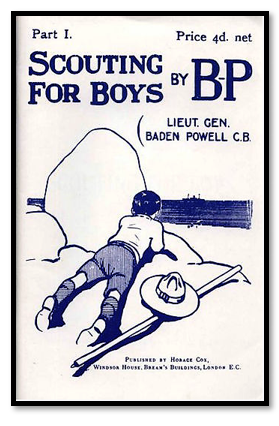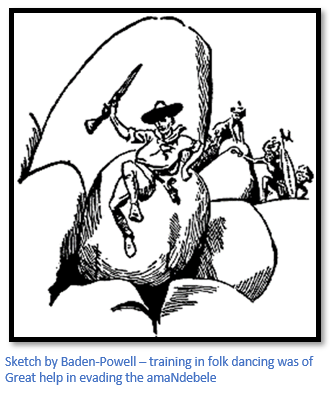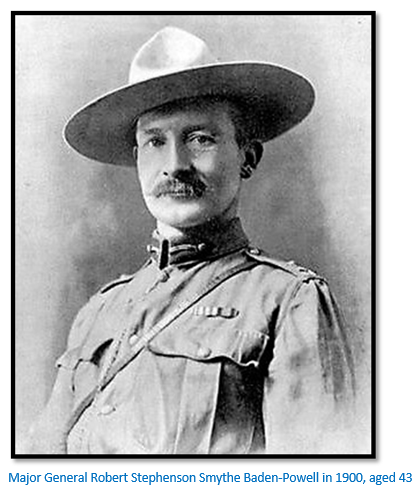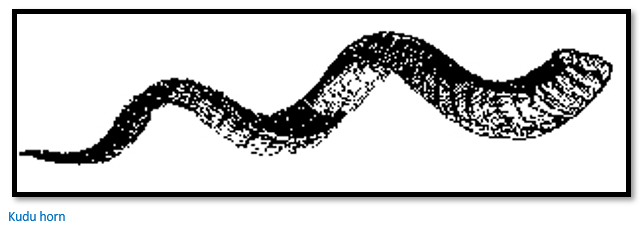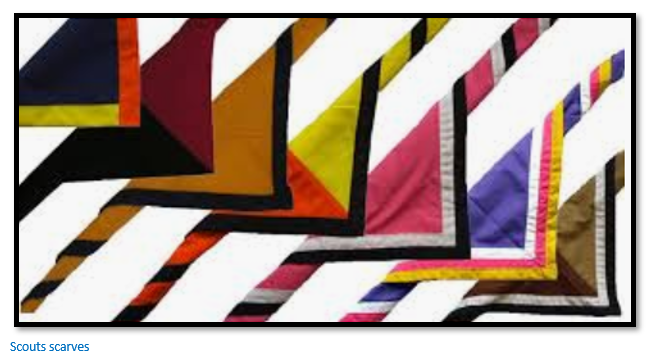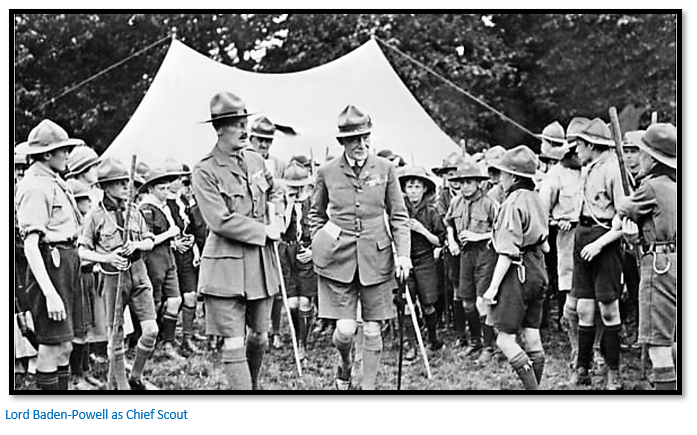Baden-Powell in Matabeleland during 1896 where he learned the principles of Scouting
Introduction
Robert Stephenson Smyth Baden-Powell (22 February 1857 – 1941) (he pronounced his name 'Poel') from very early in his life was called Stephe (pronounced Steevie) by his family, ‘B-P’ by everyone else and would only be known as Robert after he was knighted and chose to be Sir Robert. Even his surname which had been Baden was ‘improved’ by his mother to Baden-Powell.
Tim Jeal in his outstanding biography describes ‘B-P’ as an: “actor, artist, spy, hoaxer, female impersonator, author, sportsman and inspired Regimental Commander, Baden-Powell was a dazzling personality, and yet he was dominated by his formidably ambitious mother and remained acutely anxious about his manliness.” Smyth was the maiden name of his mother, Henrietta Grace. His first two names were after his godfather, only son of the famous engineer, who died when Stephe was two years old. ‘B-P’ himself wrote: “It is a well-established fact that very many of the greatest men in the world have acknowledged that they owe much of their success to the influence of their mother.” The Boy Scouts of America Collection alone has approximately two thousand letters written by ‘B-P’ to his mother between 1877 – 1814.
‘B-P’ recalled that John Ruskin, seeing him drawing with his left hand, advised his mother to let him continue using both hands – in those days parents tried to ‘cure’ left-handed actions. ‘B-P’ became ambidextrous that proved of great advantage to an artist, soldier and scout. At school he could draw with one hand and shade with the other. Lieut-General Godley who served under ‘B-P’ at the siege of Mafeking said that the trick of drawing with one hand and writing with the other never failed to draw an amused audience.
There is a memorial stone to Lord and Lady Baden-Powell in Westminster Abbey which replaced an earlier stone to Lord Baden-Powell unveiled in 1947.
The Westminster Abbey website tribute to his life entirely omits any description of 1896 - the year he was in Matabeleland – this is a major omission as Matabeleland was the first time that ‘B-P’ was able to put his theories into practice and demonstrate that scouting and reconnaissance were vital to military operations – these skills were then subsequently adapted for use during the 217 day siege of Mafeking and incorporated into the Boy Scouts movement in 1907.
Life and Career
‘B-P’ joined the 13th Hussars in 1876 as a nineteen year old 2nd lieutenant. Unlike his brothers, he had failed his entrance exams at Balliol College at Oxford being “not quite up to Balliol form.” However, when it came to a military career, there were 718 candidates sitting the examination for commissions in the infantry and cavalry; he came fifth in the infantry and second in the cavalry and was gazetted straight into the regiment, then stationed in India. From the start he showed an aptitude for and enjoyment of military scouting and irregular warfare. He also developed an aptitude for pig-sticking, winning the inter-regimental cup in 1883. ‘B-P’ took part in the Zululand (1888) the Ashanti (1895) and Matabele (1896) campaigns.
After Matabeleland ‘B-P’ was posted to the Gold Coast and served in the Fourth Ashanti War. In 1897 at the age of 40 years old, he was brevetted Colonel, the youngest of this rank in the British Army and given command of the 5th Dragoon Guards in India.
While he was on leave in England in 1899 he was summarily appointed to raise a force of mounted rifles to be based in Mafeking with the secret aim of making raids on the Boers in Transvaal.
During the Boer War he held Mafeking under siege for 217 days until relieved. In 1910 he retired from the army in order to devote himself to the Boy Scout movement which he founded.
B-P was appointed Colonel of the 13th Hussars in 1911. He remained as such through the amalgamation with the 18th Hussars.
A detailed summary of his military life and career is given at the end of this article.
Note to readers. Readers are reminded that many of the quotes were written a long time ago and use terms and expressions that were current at the time, regardless of what we may think of them today. For reasons of historical accuracy they have been included in their original form with asterisks. Also, I have converted ‘B-P’s miles into kilometres.
BP’s military experience prior to Matabeleland
With his regiment, the 13th Hussars at Lucknow ‘B-P’ completed an eight month garrison course and was posted to Kandahar in Afghanistan and drew maps of the battlefield of Maiwand where the British force had been defeated which were later used in the court-martial of the officers involved. On outpost duty and reconnaissance he much admired the Afghans ability to move silently and their courage and fighting qualities.
Back in India he enjoyed polo and pig-sticking as: “It teaches a man to ride by forcing him to exert to the utmost all his riding powers without any effort of mind; by making him anticipate the moves of the boar and regulate his own accordingly and to the best advantage of the ground; it teaches a man to use his wits and powers of observation, and gives him an eye for country; it trains him to decide in his course of action without a moment’s hesitation; it gives him practice in the use of a weapon while moving at speed, in an encounter with a strong, infuriated boar, it teaches him self-reliance and to keep his head and his pluck in an emergency; in a word, it excels all other methods of training in essential qualifications of a successful soldier on active service.”
At Muttra in 1883 he won India’s greatest prize for pig-sticking; the Kadir Cup.
In 1884 the 13th Hussars were moved to Natal as support for the Warren expedition because the Transvaal Boers with the support of Germany were attempting to annex Bechuanaland. No fighting was carried out, but ‘B-P’ carried out a month long reconnaissance of the Drakensberg mountains and corrected the existing maps.
Back in England he trained his squadron to use hand-signals instead of shouted orders and honed his spying activities on holiday in Germany and by observing Russian manoeuvres.
By 1888 he was back in South Africa as aide-de-camp (ADC) to his uncle, General Sir Smythe, General Officer Commanding (GOC) South Africa where his uneventful life was interrupted by unrest in Zululand led by Cetewayo’s son, Chief Dinizulu. Dinizulu’s army reinforced by other Zulu, soon had Asst-Commissioner Pretorius trapped in his fort at Umsundusi, fifty miles from Eshowe.
General Smythe send 500 troops of the Inniskilling Dragoons and Fusiliers and 2,000 ‘friendly’ Zulus under John Dunne; the whole force under Major McKean with ‘B-P’ as staff officer to relieve the fort. ‘B-P’ never forgot the sight of the Zulus advancing in three long lines and chanting their songs in parts – it became the basis of the Een-gon-yama chorus – known to thousands of Boy Scouts.
The relief march under appallingly wet conditions covered fifty miles in two days and relieved the fort. McKean gave much credit to his staff officer: “I beg to bring to the notice of the Lieutenant- General Commanding, the invaluable services rendered me by Captain Baden-Powell. This officer’s unflagging energy, his forethought and thorough knowledge of all military details were of the greatest assistance to me.” ‘B-P’ was kept busy in the field rounding up small groups of Zulu’s, seizing arms and receiving surrenders. For his useful work ‘B-P’ was appointed Brevet Major and appointed military secretary to the GOC at Cape Town.
General Smythe wanted to crush the Zulu; Sir Arthur Havelock, the Natal Governor thought the Zulu were misguided and wished to hold back the military forces – this was a situation that ‘B-P’ was to experience in Matabeleland between General Carrington and Sir Hercules Robinson when he ordered the execution of Chief Uwini. His military experiences brought ‘B-P’ to the attention of the Adjutant-General of the Army, Lord Wolseley who had also fought the Zulu in 1879.
In 1889 he was sent to Swaziland which was still independent although the Transvaal Boers had designs on the territory and were steadily infiltrating – ‘B-P’s precis of the situation led to his being appointed private secretary of the British Commissioner, Sir Francis de Winton. Eventually dual Boer-English administration was set-up, but it did not work well and a British Protectorate was established in 1906. This experience of political negotiation and compromise was to prove useful experience to ‘B-P.’ He admired the Zulu method of training their youth which was to send them alone into the forest or veld with weapons to ‘live off the land’ – he thought it encouraged initiative and taught them to fend for themselves which developed fitness, resource and self-reliance in the boys.
In 1890 he accompanied his uncle General Sir Smythe as military secretary and ADC to Malta. Armed with a butterfly net and sketch book he surreptitiously made plans of forts in the Adriatic and the Bosphorus and watched military manoeuvres.
In 1893 he resigned his Malta post and re-joined the 13th Hussars in Ireland and caught the eye of General Wolseley, the Army’s Commander-in-Chief. A year later on manoeuvres in Berkshire he was Brigade-Major to General French and gained a special mention for the smooth handling of scouting and reconnaissance. Wolseley asked ‘B-P’ for a report on cavalry machine-gunners.
In 1895 Wolseley picked him for special services in West Africa. Prempeh. the King of Ashanti had refused all attempts to make his country a British Protectorate. Sending troops up a narrow path through thick jungle for 145 miles called for organization and precaution. In charge was Colonel Sir Francis Scott and ‘B-P.’ Native levies were raised and armed; bridges built, seven supply bases constructed and a telegraph line laid alongside the track; tsetse fly ruled out the use of horses so native carriers were hired. After a difficult and dangerous journey which took a month in wet conditions the King’s village at Kumassi was reached and taken without fighting. Prempeh was forced to pay tribute and exiled to the Seychelles.
For his part ‘B-P’ was promoted to Brevet Lieut-Colonel at the age of thirty-eight and re-joined his Regiment, the 13th Hussars in Ireland with the next step in Matabeleland, but first some background to the events there.
Scouting
It will be seen from the text that ‘B-P’ learned many of the practical skills of surviving in the wild and the skills of scouting from his military experiences in Matabeleland. The two scouting practitioners who taught him the most about the art of scouting were both present in Matabeleland in 1876 – Jan Grootboom described below and Frederick Russell Burnham, the American Scout who had managed to escape the disaster of the Shangani patrol disaster on 4 December 1893 when he was sent by Allan Wilson with Ingram and Gooding to get reinforcements from the main column. Burnham was ‘B-P’s inspiration for the Boy Scout movement and in later life played a large part in the Boy Scouts of America earning their highest honour and was active in the organisation until his death in 1947.
B-P’s Book The Matabele Campaign 1896
The book was written as an illustrated diary and in the preface written on 12th December 1896 at Umtali, Mashonaland he wrote:
My dear Mother,—It has always been an understood thing between us, that when I went on any trip abroad, I kept an illustrated diary for your particular diversion. So I have kept one again this time, though I can’t say that I’m very proud of the result. It is a bit sketchy and incomplete, when you come to look at it. But the keeping of it has had its good uses for me.
Firstly, because the pleasures of new impressions are doubled if they are shared with some appreciative friend (and you are always more than appreciative).
Secondly, because it has served as a kind of short talk with you every day.
Thirdly, because it has filled up idle moments in which goodness knows what amount of mischief Satan might not have been finding for mine idle hands to do!
Jameson Raid and outbreak of the Matabele Rebellion or Umvukela
Jameson had taken with him nearly the entire British South Africa Company’s (BSAC) Police force leaving the country nearly defenceless. The Matabele rebellion or Umvukela was well-planned and co-ordinated to begin on the full moon of 29 March, but on 20 March warriors in the Esigodini area, south of Bulawayo, killed a native policeman. Over the next week over two hundred Europeans were killed on outlying stores, ranches and mines.
‘B-P’ wrote: “Patrols were promptly sent out to bring in outlying farmers, and to gather information as to the rebels’ moves and numbers. ‘Ere long the rebel forces were closing round Bulawayo. North, east, and south they lay, to the number of seven thousand at the least. Throughout the country their numbers must have been but little under ten to thirteen thousand.
Nearly two thousand of them were armed with Martini-Henry rifles. A hundred of the Native Police deserted and joined them with their Winchester repeaters. Many of them owned Lee-Metfords, illicitly bought, stolen, or received in return for showing gold-reefs to unscrupulous prospectors. And numbers of them owned old obsolete elephant guns, Tower muskets, and blunderbusses. So that in addition to their national armament of assegais, knobkerries, and battle-axes, the rebels were well supplied with firearms and also with ammunition.”
The remaining settlers (there were an estimated three to four thousand Europeans in the country at the time) retreated into laagers of sandbagged wagons at Bulawayo, Gwelo, now Gweru, Selukwe now Shurugwi, and Belingwe now Mberengwa, which were fortified with barbed wire, the area outside covered in smashed glass. Those few remaining British South Africa Company Police plus civilian volunteers were formed into the Bulawayo Field Force (BFF) These forces rode out to rescue settlers as soon as they were mustered and once sufficient defences static defences were in place went on the offensive against the amaNdebele. Mounted patrols were sent out under Selous to the south and Maurice Gifford to the Insiza river.
‘B-P’ wrote: “We now went through the Mangwe Pass. The road here winds its way through a tract of rocky hills and koppies, which are practically the tail of the Matopo range, running eastward hence for sixty miles. It would have been a nasty place to tackle had the Matabele held it. They might easily here have cut off Bulawayo from the outer world, but their M’limo, or oracle, had told them to leave this one road open as a bolt‑hole for the whites in Matabeleland. They had expected that when the rebellion broke out, the whites would avail themselves en masse of this line of escape; they never reckoned that instead they would sit tight and strike out hard until more came crowding up the‑road to their assistance.”
In late May two relief columns arrived in Bulawayo on almost the same day; Rhodes and Beale bringing a relief column of two hundred and fifty men from Victoria, now Masvingo and Salisbury, now Harare in Mashonaland and Lord Grey and Plumer Kimberley and Mafeking with the Matabeleland Relief Force of six hundred Europeans and two hundred Fengu soldiers, previously known as Fingo from the Eastern Cape.
Major-General Carrington appointed to lead the Imperial Forces in Matabeleland
Carrington since 1885 had been Commander of the Bechuanaland Border Police (BBP) and from 1889 expanded this force on the orders of the Colonial Office in order to provide an armed protection force to accompany the British South Africa Company’s Pioneer Column into Mashonaland from Macloutsie on 28 June 1890 until its disbandment at Salisbury on 1 October 1890. This force was led by Lieut-Col. Edward Graham Pennefather [See the article on Pennefather under Harare on the website www.zimfieldguide.com]
Carrington left the BBP in 1893 to act as military adviser to Sir Henry Loch, High Commissioner for Southern Africa in Cape Town and in 1895 on receiving his promotion to Major General he left Africa for a new appointment as military commander of the Gibraltar garrison. This did not last long as on 18 May 1896 he was appointed in command of all military forces in the Bechuanaland Protectorate, Matabeleland and Mashonaland. These comprised the BBP, Bulawayo Field Force (BFF) the Matabeleland Relief Force (MRF) under Plumer, Imperial troops under Alderson and two companies of Fengu soldiers (often referred to at the time as Cape Boys)
In view of all his experience in South Africa from consolidating Britain’s hold over Griqualand West in 1876 to the various frontier wars against the Xhosa in 1877, the Pedi in North-Eastern Transvaal in 1878, the Basuto Gun War of 1880-81, Carrington seemed a sensible choice, however Oliver Ransford portrays him as: “now a swollen caricature of the dashing cavalry officer.”
Appointment of Baden-Powell as Chief of Staff
Soon after the debacle of the Jameson Raid (29 December 1895 – 2 January 1896) ‘B-P’ was in his barracks at the end of the Falls Road in Belfast; the squadron’s horses stabled with the Shire and Clydesdale horses known as “trammers” that pulled the city’s trams. The regimental parade ground was so boggy that riding instruction was carried out the main road: “which was hard on the horses’ legs and considerably interfered with the traffic” as well as dangerous…in the last week of April a trooper fell from his horse and subsequently died. ‘B-P’ was officiating at his funeral when a telegram arrived from General Sir Frederick Carrington that said that Carrington was leaving for South Africa enroute to Matabeleland and wanted ‘B-P’ as his Chief Staff Officer.
WAR OFFICE, S.W., 28th April 1896.
SIR,
Passage to Cape Town having been provided for you in the s.s. Tantallon Castle, I am directed to request that you will proceed to Southampton and embark in the above vessel on the 2nd May by 12.30 p.m., reporting yourself before embarking to the military staff officer superintending the embarkation.
You must not ship more than 55 cubic feet.
I am further to request you will acknowledge the receipt of this letter by first post and inform me of any change in your address up to the date of embarkation.
You will be in command of the troops on board.
I have the honour, etc.,
EVELYN WOOD, Q.M.G.
Field Marshall Viscount Wolseley, Commander in Chief of British Forces, named Major-General Sir Frederick Carrington, now 51 years old, to command the British forces being sent to Matabeleland. Wolseley had visited George Baden-Powell, then Conservative MP for Liverpool Kirkdale and ‘B-P’s elder brother at his house in Eaton Square on 14 April 1896 where George urged Wolseley to appoint Carrington to command the Imperil forces destined for Rhodesia, now Zimbabwe.
In early May ‘B-P’ was onboard the S.S. Tantallon Castle for South Africa and left Cape Town on 19 May arriving sixty hours later in Mafeking. “At last, after three nights and two days jogging along in the train, we rattle into Mafeking at 6am…Sir Frederick is here, and we, the staff, take up our quarters for a few days in a railway carriage on a siding. The staff consists of Lieutenant‑Colonel Bridge, A.S.C., as Deputy Assistant Adjutant‑General (for Transport and Supply), Captain Vyvyan, Brigade Major; Lieutenant V. Ferguson, A.D.C. my billet is Chief Staff Officer.” The rinderpest had killed almost all the cattle and transport was scarce and ‘B-P’ joined Carrington and other officers for the nine hundred kilometre journey in a Zeederberg coach drawn by mules: “Packed up our kits, and in the, afternoon embarked, the four of us (the General, Vyvyan, Ferguson, and self) in the coach for Bulawayo. The coach a regular Buffalo Bill‑Wild West‑Deadwood affair; hung by huge leathers on a heavy, strong‑built undercarriage ; drawn by ten mules. Our baggage and three servant-soldiers on the roof ; two native drivers (one to the reins, the other to the whip). Inside are four transverse seats, each to hold three, thus making twelve "insides." Luckily we were only four, and so we had some room to stretch our legs. We each settled into a comer, and off we went, amid the cheers of the inhabitants of Mafeking. One, more eager than the rest, a former officer of Sir Frederick’s in the Bechuanaland Police, jumped on, and came with us for thirty miles, trusting to chance to take him back again.”
‘B-P’ noted: “Thus, when we arrived a week later, we found that the immediate neighbourhood of Bulawayo had been cleared of the enemy, but the impis were still hanging about in the offing and required to be further broken up.
The General’s plan, accordingly, was to send out three strong columns simultaneously to the north-east, north, and north-west, for a distance of some sixty to eighty miles, to clear that country of rebels, and to plant forts which should prevent their reassembly at their centres there and would afford protection to those natives who were disposed to be friendly. The southern part of the country, namely, the Matopo Hills, was afterwards to be tackled by the combined forces on their return from the north. Such was the situation in the beginning of June.”
Baden-Powell’s role in Matabeleland
Initially his role as Carrington’s Chief Staff Officer was complete charge of all the administration connected with military stores and materials, transport, munitions, remounts and medical supplies for the entire force. He worked from a small corrugated-iron shed sending orders by telegraph; the amaNdebele had failed to cut the telegraph line connecting Bulawayo with Mafeking. Existing supplies in the country were almost exhausted and the rinderpest had killed most of the transport oxen.
“The office work, although exacting, is most interesting all the same; the only drawback is that there are not more than twenty-four hours in a day in which to get it done. I certainly do look forward, though, to the hour of luncheon; yes, it sounds greedy but it is for the glimpse of sunlight that I look forward, not the lunch. That is scarcely pleasant either to look forward to or to look back on, consisting, as it generally does, of hashed leather, which has probably got rinderpest, no vegetables, and liquid nourishment at prohibitive prices, e.g. local beer at 2s. a glass. I live on bread, jam, and coffee, and that costs 5s. a meal; and prices are rising! Fags are 32s. a dozen, and not guaranteed fresh at that.”
He was praised for his military orders which in a few lines: “told all one wanted to know and in other things, left one a free hand.” Another Officer said: “He never seemed to be in a hurry, or to be overworked, or have a care on his mind.”
He was also known for his eccentric dress which included wearing: “a peculiar pair of riding breeches…like those effected by stage inn-keepers or Tyrolean hunters” and another trooper remembered ‘B-P’ wearing a cowboy hat and holsters for two revolvers.
When the military operations moved from a defensive to a more offensive role with the engagements at Ntaba zika Mambo and in the Matobo Hills the logistical problems around the supply and transport of men and supplies became more complicated and ‘B-P’s workload increased considerably.
Baden-Powell’s first engagement on the Umgusa river with the amaNdebele
On the evening of 5 June Sir Charles Metcalfe and Frederick Russell Burnham came into Carrington ‘s office; they had been planning to visit Beale’s relief force five kilometres out of town but stumbled upon a large hidden impi near the Umgusa river and quickly returned to Bulawayo.
“There, in the early dawn, I was at last able to see the enemy clear enough. On the opposite bank of the Umgusa River they were camped in long lines, fires burning merrily, and parties of them going to and from the stream for water. I took my information on to Beal’s camp. I was much taken with the coolness with which the news was received there. It was not above two miles and a half from that of the enemy.
Our strength was 250 mounted men, with two guns and an ambulance. The country was undulating veldt covered with brush, through which a line of mounted men could move at open files.
As we advanced, we formed into line, with both flanks thrown well forward especially the right flank under Beal, which was to work round in rear of the enemy on to their line of retreat, a duty which was most successfully carried out. The central part of the line then advanced at a trot straight for the enemy’s position.
The enemy were about 1,200 strong, we afterwards found out. They did not seem very excited at our advance, but all stood looking as we crossed the Umgusa stream, but as we began to breast the slope on their side of it, and on which their camp lay, they became exceedingly lively, and were soon running like ants to take post in good positions at the edge of a long belt of thicker bush. We afterwards found that their apathy at first was due to a message from the M’limo, who had instructed them to approach and to draw out the garrison, and to get us to cross the Umgusa, because he (the M’limo) would then cause the stream to open and swallow up every man of us. After which the impi would have nothing to do but walk into Bulawayo and cut up the women and children at their leisure.
But something had gone wrong with the M’limo’s machinery, and we crossed the stream without any contretemps. So, as we got nearer to the swarm of black heads among the grass and bushes, their rifles began to pop and their bullets to flit past with a weird little ‘phit, phit,’ or a jet of dust and a shrill ‘wh-e-e-e-w’ where they ricocheted off the ground. Some of our men, accustomed to mounted infantry work, were now for jumping off to return the fire, but the order was given: No; make a cavalry fight of it. Forward! Gallop!”
This was ‘B-P’s first and only cavalry charge in his career. He has several close escapes from death – a warrior dropped to his knees and fired at point-lank range but missed and a shot fired from a tree struck the ground at his feet.
In this action they suffered only four men seriously wounded and four horses killed; he later admitted that: “this was a very one-sided fight and it sounds rather brutal to anyone reading in cold blood how we hunted them down without giving them a chance – but it must be remembered we were but 250 men against at least 1,200.”
This battle was a turning point for the amaNdebele and by the time Carrington arrived on 22 June 1896 the amaNdebele had begun to lose the initiative and split into two main groups; the smaller one heading for Ntaba zika Mambo and the larger for the Matoppos hills, now called the Matobo. Both held Mlimo shrines and offered refuge in granite kopjes honeycombed with caves and hiding places covered with thick bush and slashed with ravines - ideal terrain for waging irregular warfare. In the 1893 occupation of Matabeleland the amaNdebele impis had experienced the devastating firepower of the Maxim guns and would not engage in full-frontal attacks again.
Ntaba zika Mambo
Within a short period of his arrival Carrington had given Plumer permission to use most of their combined force for a full-scale attack on Ntaba zika Mambo. The force left Inyati, now Inyathi Mission on the night of 5 July
“Colonel Plumer accordingly took a column out there, nearly 800 strong, and, after a clever and most successful night-march, surprised the enemy, at dawn, on 5th July, in a desperate-looking kopje stronghold called Ntaba zika Mambo. There was some tough fighting, and the newly-arrived corps of "Cape Boys" (natives. and half-castes from Cape Colony), much to everybody’s surprise, showed themselves particularly plucky in storming the koppies; but, as in the case of most natives, their élan is greatly a matter of what sort of leaders they have, and in this case there was every reason for them to go well. Major Robertson, their commandant, an old Royal Dragoon, is a wonderfully cool, keen, and fearless leader under fire.
In the end the place and its many caves was taken. Our loss amounted to ten killed, twelve wounded. The enemy lost 150 killed, and we got some 600 prisoners, men, women, and children, 800 head of cattle, and a very large amount of goods which had been looted from stores and collected at this place as the property of the Mlimo. It was a final smash to the enemy in the north, though Mkwati, the local priest of the Mlimo, and Uwini, his induna, both escaped.
The Mlimo’s cave was found, a most curious place, which I visited later on: a sort of ante-room in which suppliants had to wait while the priest went away to invoke the Mlimo’s attention; then a narrow cleft by which they would walk deep into the rock, and which narrowed till it looked like a split just before the end of the cave. And through this crevice they made their requests and got their answer from the Mlimo. In reality, another cave entered the hill from the opposite side and led up to this same crevice, and it was by this back entrance that the priest re-entered and sitting in the dark corner just behind the crevice, he was able to impersonate an invisible deity with full effect.
Of such caves there are three or four about the country, where the rebels must now get their orders as to their course of action.”
Although large numbers of women and children and cattle were captured, the main body of amaNdebele fighters managed to escape to the Matobo hills the refuge of the Mlimo, their spiritual leader. Mkwati the spiritual leader at Ntaba zika Mambo and his father-in-law Chief Uwini escaped east to the Somabhula forest. [See the article Battle of Ntaba zika Mambo, Manyanga or Mambo Hills under Matabeleland North on the website www.zimfieldguide.com]
‘B-P’ comments as follows: “I was scouting out with my native boy [Jan Grootboom] in the neighbourhood of the Matopos. Presently we noticed some grass-blades freshly trodden down. This led us to some foot-prints on a patch of sand; they were those of women or boys, because they were small; they were on a long march [about 110 kilometres from Ntaba zika Mambo to the Matobo] because they wore sandals; they were pretty fresh, because the sharp edges of the foot-prints were still well-defined, and they were heading for the Matopos. Then my n****r, who was examining the ground…suddenly started…found not a foot-mark, but a single leaf. But that leaf meant a great deal, it belonged to a tree that did not grow in this neighbourhood, though we knew of such trees ten or fifteen miles away. It was damp and smelt of k****r beer. From these two signs then, the foot-prints and the beery leaf, we were able to read a good deal. A party of women had passed this way, coming from a distance ten miles back, going toward the Matopos and carrying beer…They had passed this spot about 4 o’clock that morning, because at that hour there had been a strong wind blowing, such as would carry the leaf some yards off their track…”
Reconnaissance into the Matobo
Co-ordinated attacks were made into the Matobo hills in late July and early August but resulted in a short engagements during which the amaNdebele withdrew further into the hills without any military advantage for the MRF and they incurred heavy casualties.
‘B-P’ made his first journey into the Matobo on 12 June with the American scout Frederick Burnham
In the following months he made six more exploratory missions into the Matobo generally just with one or two companions. He was delighted to discover that the amaNdebele had given him a nickname as was their custom which was “Impeesa” – the hyena or creature that does not sleep but walks about at night. ‘B-P’ as was his custom, changed the hyena into “the wolf that never sleeps” as his own translation and used it at the siege of Mafeking to enhance his reputation as a watchful military scout. The nickname was also used for a gun manufactured in the railways workshop at Mafeking using four-inch steel furnace pipe strengthened by rails bent into rings and a chassis from an old threshing machine. Scrap metal was melted down into spherical shells and the home-made gun named `the Wolf' in honour of Baden-Powell could fire an 8kg projectile almost 4,000 metres.
“The net result of our scouting to date is that we have got to know the nature of the country and the exact positions of the six different rebel impis in it, and of their three refuges of women and cattle. Maps have been lithographed accordingly and issued to all officers for their guidance. These maps have sketches of the principal mountains to guide the officers in finding the positions of the enemy.”
“The Matopo district is a tract of intricate, broken country, containing a jumble of granite-boulder mountains and bush-grown gorges, extending for some sixty miles by twenty. It lies to the south of Bulawayo, its nearest point being about twenty miles from that town. Along its northern edge, in a distance of about twenty-five miles, the six separate impis of- the enemy have taken up their positions, with their women and cattle bestowed in neighbouring gorges.
On the principle, Gutta cavat lapidem non vi sed saepe cadendo [a water drop hollows a stone not by force but by falling often] we have taken innumerable little peeps at them and have now marked down these impis and their belongings in their separate strongholds, a result that we could never have gained had we gone in strong parties.
Commencing at the western end, near the Mangwe road is the stronghold of the Inugu Mountain, a very difficult place to tackle, with its cliffs, caves, and narrow gorges. The impi occupies the mountain, while the women and cattle are in the neighbouring Famona valley.
Five miles N.E. of this is the Chilili valley, in which are women and cattle of Babayan’s impi. This impi is located deep in the hills near Isibula’s Kraal on the Kantolo Mountain; while Babayan himself, and probably the priest of the M’limo, are in a neighbouring valley.
Eighteen miles to the eastward, eight miles south of Dawson’s Store on the Umzingwane River, we come to a bold peak, that is occupied by Inyanda’s people, with a valley behind it, in which are Sikombo’s women and cattle.
A couple of miles farther west, Sikombo’s impi is camped behind a dome-shaped mountain close to the Tuli road.
On the west side of this road Umlugulu’s impi was stationed when we first began our reconnaissance, but he moved nearer to Sikombo, with Mnyakavula close by. Each impi numbered roughly between one and two thousand men. Their outposts were among the hills along the northern bank of the Umzingwane River. We used to pass between these by night, arriving near the strongholds at daybreak.”
Jan Grootboom
‘B-P’ went on several scouting missions with Jan Grootboom, an extremely skilful and resourceful Fengu (previously known as Fingo) from the Eastern Cape who made the initial contacts with the amaNdebele Chiefs that proceeded the first Indaba.
Baden-Powell learnt many of his scouting skills from observing Grootboom and in his memoirs of the Matabele Campaign in 1896, he frequently mentions him, although he incorrectly refers to him as a Zulu. Grootboom had come to Matabeleland as a wagon driver for Charles Helm, the missionary at Hope Fountain Mission. At the height of the campaign, Grootboom distinguished himself as a courageous and exceptional man especially when it came to night reconnaissance around the amaNdebele camps and outposts.
Baden-Powell writes: “He had the guts of the best of men. Though I knew Zululand, I was new to Rhodesia and its people and I needed therefore a really reliable guide and Scouting comrade.
To do our job he and I used to ride out from our outpost as soon as night had set in. This enabled us to get through the intervening 25 miles of country in good time to conceal ourselves near the enemy position at dawn, then to ascertain his exact whereabouts by observing his camp-fires as they lit up for cooking the morning meal. Our work lay among rocky kopjes. I found with my rubber-soled shoes I was able to get about more rapidly than Jan and in fact the enemy. In this way the enemy got to know me fairly well; they gave me the name of 'Impeesa'- the beast that creeps about at night.
One night we had crept down to near the enemy stronghold and were waiting there to see his morning fires so as to ascertain his position. Presently the first fire was lit and then another and yet another. Jan suddenly growled: The brutes are laying a trap for us. He slipped off all his clothing and left it lying in a heap and stole off into the darkness practically naked. The worst of spying is that it makes you suspicious, even of your best friends; so as soon as Jan was gone I crept away in another direction, taking the horses with me, and got among some rocks where I would have some chance if he had any intention of betraying me. For an hour or more I lay there while the sun rose until, at last, I saw Jan crawling back through the grass - alone. Ashamed of my doubts, I crept to him and found him grinning all over with satisfaction while he was putting on his clothes again. He said that he had found, as he had expected, an ambush laid for us. The thing that made him suspicious was that the fires, instead of flaring up at different points all over the hillside simultaneously, had been lighted in steady succession, one after the other, apparently by one man going around to light them. He himself had pressed in towards them by a route from which he was able to perceive a party of them lying out in the grass close to the track which we should probably have used had we gone on.”
Grootboom had great respect for Baden-Powell who he called “Colonel Baking Powder” an obvious reference to ‘B-P’ and taught him many of the basic techniques of scouting and reconnaissance. Always to check for any clothing that might betray his presence, avoiding the skyline and keeping perfectly still for long periods. Scouting mostly at night when it was easier to slip between sentries; always having an alternative escape route and returning by a different route to avoid an ambush.
“For efficient scouting in rocky ground, in the dry season, India rubber-soled shoes are essential; with these you can move in absolute silence, and over rocks which, from their smoothness or inclination, would be impassable with boots. It is almost impossible to obliterate your spoor, as, even if you brush over your footprints, the practised eye of the native tracker will read your doings by other signs; still, it is a point not to be lost sight of for a minute when getting into position for scouting, and a little walking backwards, doubling on one’s tracks over rocky ground…”
Frank Sykes pays particular tribute to Grootboom’s services. “His services as a spy upon the positions and movements of the enemy have been invaluable. Possessing an intimate knowledge of the country and the customs and tactics of the natives, combined with courage and absolute self-reliance he was just the type pf man most adapted by nature and disposition for purposes of espionage.”
‘B-P’ praises Plumer for his surprise night attack on the amaNdebele at Ntaba zika Mambo; Sykes reveals that Grootboom left Bulawayo six days before Plumer’s column on foot. Once he arrived he lay concealed amongst some rocks not far from the stronghold and says: “At night I went into the mountains and saw every place where the enemy was. I saw the Matabele’s cattle in the kraal and went close up to their scherms where they were busy cooking. At one place I could plainly hear them talking. I went in from the east side of the hills and after seeing where all their fires were I went right round to the other side. Here I was very nearly caught. I was going through a narrow place between two large rocks and when I looked back I saw a fire just behind where I had come in and another one above me. I had to pass these again on my way out. From one spot on top of the rocks I could see something white against the fires and after a little time I made out the wheels of a wagon which they had there. Later on at night a great number of the Matabele started dancing and singing. I could not say how many there were, but they must have been a very large impi as their fires could be seen whichever way I looked. A lot of them who had been to consult the war doctor at Thabas Amamba returned to the Matoppos before Colonel Plumer’s Column arrived at Inyati.”
He had less respect for the hill-fighting tactics of the MRF in the Matobo: “The Column would march into the hills and have a fight and then at night go back to camp. This is no way to fight the Matabele. You must sleep in the hills after the battle and keep on following the enemy from one kopje to another and kill so many that you break his heart. But instead of that, you go back to camp; the Matabele thinks you have had enough of it and soon they collect together again and are more confident than ever. No, the white man doesn’t understand fighting among the rocks. They go out in the open and let the Matabele shoot and shoot and down they fall. I saw one man walk out from behind a rock and as he did so, a Matabele shot him through the head. But you don’t see Colonel Baking-Powder do that. If they want to shoot him, they must go after him, catch him out from where he hides. He knows better to stand up to be shot at.”
16 – 24 July fighting in the Matobo
Following their retreat from Ntaba zika Mambo many of the amaNdebele made their way to the Matobo Hills and Colonel Plumer decided to follow-up as MRF morale was high. ‘B-P’ was chosen as guide to the force of over 1,000 men but it soon became apparent that the Matobo represented a much greater obstacle. The amaNdebele were well armed with Martini-Henry rifles which deserting Matabeleland Native Police had taken with them although they lacked ammunition, and which ‘B-P’ says in letters to his brother George and Major C.B. Vyvyan, local prostitutes attempted to improve by charging ammunition for their services. the broken kopje country criss-crossed by numerous steep-sided valleys and streams gave the amaNdebele unlimited cover and made movement by regular forces extremely difficult.
“The rebels in the south have every reliance, and with reason, on the impregnability of their rock-strongholds; and their confidence is strengthened by their store of grain and cattle, which were being brought, long before the outbreak into the hills by the M’limo’s orders. Of arms and ammunition they have plenty, although the puzzle is to say from whence they come. But there they are Martinis, Lee-Metfords, Winchesters, besides the blunderbusses and elephant guns, which at the close quarters of this fighting make very deadly practice.”
The Chiefs and their followers when attacked simply retreated from their kopje strongholds into new defensive positions and sniped at their attackers from the shelter of the caves. By 24 July twenty MRF soldiers had been killed for no strategic gain and ‘B-P’’s intelligence gathering patrols into the Matobo achieved little in the way of useful information although they knew the approximate position of each of the chief’s.
Early Matobo skirmishes – attack on Babayane
“19th July.—At last out time came. The order was given to the men in the morning, " Bake two days’ bread, and sleep all you can this afternoon." At what was usually our bedtime the whole column paraded without noise or trumpet call, and at 10.30 we moved off in the moonlight into the Matopos.
I was told off to guide the column, because I knew the way. I preferred to go alone in front of the column, for fear of having my attention distracted if anyone were with me, and of my thereby losing my bearings. And there was something of a weird and delightful feeling in mouthing along alone, with a dark, silent square of men and horses looming along behind one. Neither talking nor smoking was allowed-for the gleam of a match lighting a pipe shines a long way in the darkness. Except for the occasional cough of a man or snort of a horse, the column, nearly a thousand strong, moved in complete silence. Once a dog yelped with excitement after a buck started from its lair; the orders for the night expressly stated that no dog should go with the column, and accordingly this one was promptly caught and killed with an assegai.
Soon after midnight we were within a mile of the place; the square halted, and each man lay down to sleep just where he stood-and jolly cold it was. An hour before dawn we were up and on our way again, moving quietly onwards until we were close to the pass among the koppies which led into the enemy’s valley. Here, just as dawn was coming on, we left the ambulance and a reserve of men, together with our greatcoats and other impedimenta, and formed our column for attacking the stronghold.”
“…And so we advanced in the growing daylight into the broken, bushy valley, which was surrounded on every side by rough, rocky cliffs and koppies. Fresh paths and spoor showed that hundreds of rebels-must be living here, and at last I jumped with joy when I spotted one thin streak of smoke after another rising among the crags on the eastern side of the valley. My telescope soon showed that there was a large camp with numerous fires, and crowds of natives moving among them. These presently formed into one dense brown mass, with their assegai blades glinting sharply in the rays of the morning sun. We soon got the guns up to the front from the main body, and in a few minutes they were banging their shells with beautiful accuracy over the startled rebel camp...”
At this point the amaNdebele simply vacated their overnight position, leisurely crossed an open valley with a small stream and retired into an adjacent kopje. ‘B-P’ and a small group of native scouts occupied the kopje from which the amaNdebele had just quit.
These, though recently occupied by hundreds of men, were now vacate, and one had an opportunity of seeing what a rebel strong hold was like from the inside; all the paths were blocked and barricaded with rocks and small trees; the whole place was honeycombed with caves to which all entrances, save one or two, were blocked with stones; among these loopholes were left, such as to enable the occupants to fire in almost any direction. Looking from these loopholes to the opposite side of the gorge, we could see the enemy close on us in large numbers, taking up their position in a similar stronghold…”
Then the skirmishing begins….
“…The Cape Boys, after making a long circle round through part of the stronghold, reassembled at this spot, and from it directed their further attacks on the different parts and it became the most convenient position for the machine guns, as they were able to play in every direction in turn from this point. For the systematic attack on the stronghold a portion of it is assigned to each company, and it is a pleasing sight to see the calm and ready way in which they set to work. They crowd into the narrow, bushy paths between the koppies, and then swarm out over the rocks from whence the firing comes, and very soon the row begins. A scattered shot here and there, and then a rattling volley; the boom of the elephant gun roaring dully from inside a cave is answered by the sharp crack of a Martini-Henry; the firing gradually wakes up on every side of us, the weird whisk of a bullet overhead is varied by the hum of a leaden coated stone, or the shriek of a pot-leg fired from a Matabele big bore gun; and when these noises threaten to become monotonous, they are suddenly enlivened up by the hurried energetic "tap, tap, tap" of the Maxims or the deafening "pong" of the Hotchkiss. As you approach the koppies, excitement seems to be in the air; they stand so still and harmless-looking, and yet you know that from several at least of those holes and crannies the enemy are watching you, with finger on trigger, waiting for a fair chance. But it is from the least expected quarter that a roar comes forth and a cloud of smoke and the dust flies up at your feet...”
The fighting begins to fizzle out as the amaNdebele fade away into the surrounding kopjes.
“…So in the meantime we did the best amateur work we could on the wounded men brought in. Of these there were six, all badly wounded; in addition to two more killed; and it is a pathetic comedy to watch the burly Royal Artillery sergeant transforming himself into a nurse for the occasion with a rough good-heartedness that does not stop to consider whether his patients are black or white.”
At the same time the plan was for Capt. Tyrie-Laing to simultaneously attack the amaNdebele on the Inugu Mountain, some fourteen kilometres to the westward – this went disastrously wrong as the force camped in a narrow valley and was attacked at dawn by the forces of Induna M’biza, Inkonkebella Holi and Dhliso from two sides [For a full account see the article Fort Umlugulu (previously Fort Nsezi, or Sugar-bush Camp) and the cemetery on the website www.zimfieldguide}
Construction of Fort Usher No 3
“22nd July - Forgot that I had been up all night and went for a bit of solitary exercise into the hills, to investigate some signs I had noted two days before of an impi camped in a new place. After a tedious bit of work, I found that they had decamped. I then went to the neighbourhood of Babayan’s stronghold, but could see no natives about there. Also, in accordance with the General’s instructions, I selected a position in which to build a fort to command this portion of the Matopos. I chose a point where there was open, fairly fiat ground for half a mile in every direction, close to a permanent stream - here there was a mighty thorn tree which would serve for a "crow’s-nest" or raised platform from which a look-out man could see well in every direction, and where a Maxim gun would command the whole of the ground round the fort. On return to camp, I drew out the design and plan of the proposed fort, and in the evening again went out there, taking with me a portion of Robertson’s Cape Boys to start work upon it the following morning. This fort was named Fort Usher, being near the site of one of Usher’s farms." [See the article Fort Usher under Matabeleland South on the website www.zimfieldguide.com]
Military operations continue
He carried out a reconnaissance of the deep Chabez gorge with Grootboom and next day during a small engagement was hit in the thigh by a stone covered in lead fired from a large-bore musket which fortunately was largely spent and left just a big bruise.
At Inyanda’s stronghold the kopje was first shelled and then: “we worked round through the bush to the rear of the mountain. Here were the caves which formed the grain stores of the rebels and after shelling these for a short time, we sent up parties to capture them. The enemy made no attempt to hold the place, but had retired over the back of the mountain, but one of them firing a parting shot wounded Captain Lloyd, our signalling officer, through the lower part of the thigh.”
At the spot where the Tuli road left the Matobo Brandt’s party had lost five killed and fifteen wounded with thirty horses killed the dead had been left on the ground, they halted and buried the dead. It was easy to follow the course of the fight from the wheels of the Maxim gun on which the wounded were carried and the bodies of the horses left in the veldt.
5 August – Battle of Tshingengoma or Sikombo’s stronghold
Sikhombo’s stronghold was attacked by the entire MRF. The attack was made at dawn in an attempt at surprise which meant the assault force needed careful mustering during the night and was led by ‘B-P’ from Fort Umlugulu to the position marked as Plumer’s main force.
Captain Beresford advanced at 6am to the position shown in order to shell the amaNdebele positions along the ridge line from the left of the sketch to the middle. The amaNdebele waited in ambush in a dip in the ground and rushed the guns; the day was saved by Captain Hoël Llewelyn who operated the Maxim gun single-handed and stopped a further charge; Tpr Holmes seeing Llewellyn unsupported ran to his assistance and was mortally wounded in the thigh and died four days later.
To the right of the seven-pounders Lieutenant Hervey was ordered to attack and as he stood on a rock waving his men forward was shot and mortally wounded. He was laid on a stretcher in the shelter of two large boulders, telling his men to continue on fighting. The engagement became more general, Capt. Jesser Coope with his scouts was unable to reach Beresford who had managed to signal that he was being heavily pressed, with Hervey severely wounded.
All the regiments of Chief’s Umlugulu and Sikombo were now engaged and the rocky ground favoured the amaNdebele who inflicted further heavy casualties. Major Kershaw led an attack at 11am to the left of the Tshingengoma Hill and was shot dead, Major Robertson’s Cape Volunteers attacked at 12am; Baden-Powell led an attack half an hour later and the AmaNdebele slowly began to retreat.
AmaNdebele losses were estimated at around 200; Plumer’s forces lost five killed and fifteen wounded, of which two subsequently died of wounds before the force moved back to their base camp at Fort Umlugulu. Two of the most popular officers were killed and the entire force left disheartened.
[This account is a summary - for details see the Battle of Tshingengoma or Sikombo’s stronghold on the website www.zimfieldguide.com]
Carrington’s lack of a strategic plan to defeat the amaNdebele
The inconclusive results of the actions in the Matobo Hills led Carrington to believe that he would only drive the amaNdebele out of their granite strongholds through a war of attrition by depriving them of ability to grow their crops and surrounding the Matobo Hills with a ring of forts. These would require an additional 2,500 Imperial troops in addition to those already in the field, the cost of which would be all be borne by the BSAC and which suggestion lost him the confidence of Rhodes.
Wikipedia states Carrington: “acquired fame by crushing the 1896 Matabele rebellion” but the reality is that all the military activities in those ‘bloody hills’ was left in the hands of Baden-Powell and Plumer and Oliver Ransford says Carrington spent much of his energy on learning to ride a bicycle around Bulawayo. The military also knew that time was not on their side – when the November rains came the problems of transport and supply would be exacerbated.
Peace negotiations with the amaNdebele
‘B-P’ played a part in the initial breakthrough in negotiations between the amaNdebele Chiefs and Rhodes. On 4 August ‘B-P’ had been scouting with Grootboom and Richardson, the Native Commissioner for the Matobo area and native scouts when they captured an old amaNdebele woman named Umzava whom they learnt was the niece of Mzilikazi, the father of Lobengula.
On 10 August they took her back to her old kraal which had been destroyed and “there we built her a new hut, hoisted a white flag, gave her two cows and some corn and an old woman prisoner to look after her. We told her all our conditions for peace and left her there.” The old woman passed on their message to the Chiefs in the hills. This led to Jan Grootboom and Johan Colenbrander having discussions with the Chiefs and to finally the first indaba in the Matobo.
Rhodes and the first Indaba
Rhodes joined Plumer and Carrington at their base at Fort Umlugulu (formerly Sugar Bush Camp) for a review of operations. The MRF were costing the BSAC £4,000 per day and now Carrington was saying additional troops were needed. Rhodes decided against the military advice he was getting and to negotiate directly with the amaNdebele Chiefs who were just a few miles away. [See the article The Matabele rising or First Umvukela Indaba site (Rhodes Indaba site) under Matabeleland South on the website www.zimfieldguide.com]
‘B-P’ commands a squadron of the 7th Hussars
‘B-P’ had hoped to join the peace negotiations but Carrington gave him command of the squadron of the 7th Hussars which was under Major Ridley with orders to complete the pacification in the region north of Gwelo, now Gweru. He takes three of Plumer’s men as escorts and rides the one hundred sixty kilometres via Inyati Mission and on the Old Hunter’s Road and finds the Hussars about forty miles to the east of the Shangani river.
The regiment of the 7th Hussars were sent to Pietermaritzburg, Natal on a routine posting when the Matabele Rebellion or Umvukela broke out at the end of March 1896. They had already handed over their horses to the 20th Hussars, so they took on the horses of the 3rd Dragoon Guards and three squadrons, under the command of Lt-Col Harold Paget, travelled down to Durban where they embarked on the 'Goth' for East London and then travelled by train to Mafeking where the Imperial troops were being assembled. Two squadrons remained in Pietermaritzburg.
Before ‘B-P’ joined the 7th Hussars after they had carried out a long patrol under Major Ridley in the Gwaai river area breaking up small parties of amaNdebele and accepting their surrender.
Following this phase the three squadrons of the regiment operated as mounted troops in the Gwelo area, then part of Matabeleland, but now in the Midlands Province, patrolling regularly with mounted infantry troops from the 2nd Battalion, York and Lancaster Regiment (the 2nd, Yorks and Lancs) with ‘B-P’ regularly commanded the patrolling squadron.
Chief Uwini
The title of Jeal’s chapter on ‘B-P’s active service in Matabeleland is ‘Mistake in Matabeleland’ and although not explained, presumably refers to the capture, court-martial and execution by firing squad of Chief Uwini.
Ranger argues that after the death of King Lobengula in 1894 the leadership of the amaNdebele was disorganized, however the Mwari cult shrines at Matonjeni, Njelele, Mangwe an Ntaba zika Mambo (despite being Makalaka and not amaNdebele) managed to unite the amaNdebele and elements of Shona and Rozvi in an attack on the Europeans – the Matabele rebellion or Umvukela. After the battle at Ntaba zika Mambo, the spiritual leader Mkwati gathered his followers, mostly Makalaka and Maholi and scattered east into the Somabhula forest situated north and west of Gwelo. Both Mkwati and his father-in-law Chief Uwini were opposed to the chiefs in the Matobo talking peace with Rhodes and took active measures against any who collaborated with the Europeans.
‘B-P’ had no sooner arrived at his new posting when he was told Chief Uwini had been captured by his forces. “He was badly wounded in the shoulder, but, enraged at being a prisoner, he would allow nothing to be done for him; no sooner had the surgeon bandaged him than he tore the dressings off again. He was a fine, truculent-looking savage and boasted that he had always been able to hold his own against any enemies in this stronghold of his, but now that he was captured, he only wished to die.” ‘B-P’ asked the old chief to order his warriors to surrender, but he refused to cooperate, with ‘B-P’ conceding that: “he is a plucky and stubborn old villain.”
‘B-P’ was now faced with a dilemma. If he sent Chief Uwini back to Bulawayo, a five day journey, he would need to split his force and the chief’s followers would probably attempt to rescue him; but ‘B-P’ had neither the manpower nor facilities to take the chief on patrol with him as a prisoner. The other real possibility was to escort him to Gwelo and wait for a suitable time for the chief to be sent to Bulawayo. Carrington had given all his officers printed orders that they were to hand prisoners over to the Native Commissioner (Val Gielgud) in charge of the area for trials in the civil courts.
Furthermore Uwini’s defiant attitude ensured that his followers would not leave their strongholds and lay down their arms which left ‘B-P’ with a number of choices:
- The prospect that the troops (7th Hussars and the 2nd, Yorks and Lancs and Afrikander Corps) would need to enter the caves and winkle them out with the prospect of further casualties. They had lost five men killed and wounded in taking one kopje and kraal; there remained seven to be taken which were likely to be as strongly defended as the first.
- Uwini as the father-in-law of Mkwati a priest of the Mlimo had boasted that he was invulnerable to bullets. This claim had already been shown to be false outside Bulawayo and if it could be shown to be false yet again, Uwini’s followers might be induced to surrender.
- N.D. Fynn, Native Commissioner for the adjoining area had spoken to local Makalaka and Maholi people and was informed that Chief Uwini and Mkwati were the driving forces behind the rebellion locally and were using force and threats to any local chiefs who might be considering peace talks. Fynn had been told that a neighbouring chief and some of his tribe had been murdered for considering surrender of their firearms. In addition, Chief Uwini was considered the instigator of the Native Commissioner and European miners being killed in the area. These were likely those buried later at Fort Ingwenya [see the article Fort Ingwenya and cemetery under Midlands on the website www.zimfieldguide.com]
Based on the above, both Native Commissioners considered an example should be made of Chief Uwini which would most likely lead to peace in the region. ‘B-P’ asked his second-in-command Major Ridley of the 7th Hussars to be president of a court-martial. Ridley thought Uwini should be sent to Bulawayo for civil trial and asked ‘B-P’ if he had the authority to arrange a court-martial. ‘B-P’ said he had the authority as Carrington’s Chief Staff Officer which Ridley accepted, but did say he had been cautioned by Carrington not to shoot any prisoners.
The court-martial began on 13 September with Chief Uwini facing the following charges:
1. With being a rebel in armed resistance to the established authority
2. With sending his followers to attack ‘friendly’ tribes
3. With killing white miners in the Gwelo area The chief considered the first charge without merit as the Europeans were not the established authority and denied the last two charges. His defence was that the Imperial forces had been searching for grain in the area and either taking or destroying them and that he was defending his people, his property and his land. The military prosecutor made much of Chief Uwini firing at the Imperial forces searching the cave in order to prove that he was: “a rebel captured while in armed resistance to constituted authority.” ‘B-P’ changed his diary to agree with this argument writing first: “Uweena fired a second time at Halifax [the trooper who wounded him] and eventually gave himself up” before changing the entry to read: “Uweena fired a second time at Halifax, before he was at length cornered and captured.”
Chief Uwini did not deny firing on the troopers who entered the cave or refusing to lay down his firearm and said he had fired because he was sure they meant to kill him. ‘B-P’ writes: “When his kraal was taken by the troops Uwini had scrambled down into the labyrinth of caves which ran through the rocks on which the kraal was built. Trooper Halifax and another crawled in after him and followed him from one point to another of his refuge often firing and being fired at by him. After some hours of this game of hide-and-seek, Halifax had managed to wound the chief; then then followed him up with a lighted candle, tracking him by his blood spoor, until they finally cornered him in the cleft of the rocks from which he could not escape. He was so disabled by his wound as to be unable to fire on them and they made him a prisoner.”
Prosecution witnesses provided the following statements:
- Two troopers stated Chief Uwini had fired two shots at them
- Gielgud, the Native Commissioner stated that Chief Uwini had refused to allow his followers to surrender their firearms
- Two local people stated Chief Uwini had sent followers to kill the white miners
- A local person stated that Makalakas or Maholi known to be neutral or friendly to Europeans were killed
Chief Uwini declined to call witnesses. The court-martial found him guilty on all three charges, sentencing him to be shot and the verdict was confirmed by ‘B-P.’ At sunset, in the presence of ‘friendlies,’ local tribesmen and prisoners, Chief Uwini was shot by a firing squad of six troopers and the body taken by his wives for burial.
‘B-P’ expected: “I have great hopes that the moral effect of this will be particularly good among the rebels, as he was the head and centre of revolution in these parts and had come to be looked upon by them as a god.” Some weeks later Native Commissioner Fynn reported: “There can be no doubt that the death of Uwinya has had the very best results in ridding the country of the chief obstacle to a peaceful settlement” and this was confirmed by Native Commissioner Gielgud who reported: “many Maholi headmen surrendered during the next two or three days…These rapid results could not have been hoped for if the prisoner had been tried and executed at a distant time and place.”
After-effects of Chief Uwini’s execution
When Sir Hercules Robinson, recently created Baron Rosmead on 11 August 1896, the High Commissioner for Southern Africa heard the news of the execution he telegraphed Carrington: “I must point out that the ordinary courts of the country are still in existence and that martial law has not been proclaimed; the execution of Uwini appears prima facie illegal and I must therefore request that as soon as possible, without prejudice to the military operations, you will place Colonel Baden-Powell under open arrest and order a Court of Inquiry.”
This Carrington declined to do, viewing this as one more example of colonial office officials interfering with military operations with Southern Africa. When news reached the British newspapers, one of the first questions they asked was ‘why martial law had not been declared when rebellion had been underway for six months? Also, why was a civilian High Commissioner issuing instructions to a General in the field sixteen hundred kilometres away?’
Robinson’s action was consistent with his reaction to the execution of Chief Chingaira Makoni which has many parallels. Chief Makoni had been captured on 3 September and Major Watts’ original intention was that he should stand trial at a civil court in Umtali, now Mutare. Ross the Native Commissioner was opposed to this plan as he argued there was a real risk of Chief Chingaira Makoni escaping which would set the whole district into a blaze, and that the safety of Umtali itself might be endangered. In fact, Chief Chingaira Makoni’s son and two of his senior advisers did manage to escape and Watts’ plan for a trial in Umtali was rapidly discarded and a court-martial was quickly convened to try Chief Chingaira Makoni for “armed rebellion.”
In spite of Chief Chingaira Makoni’s assertion that he was innocent of being a rebel; his reply being: “it is all very well to call me a rebel, but the country belonged to me and my forefathers long before you came here” he was found guilty of armed rebellion and of having caused the murder of the three traders and was sentenced to be shot. A telegram was sent to Earl Grey by Major Watts to confirm the sentence, but as the nearest telegraph Office was at Umtali, this had to be taken by native runners. Native Commissioner Ross argued that any delay in waiting until permission was received would be prejudicial to security and the sentence was carried out on the morning of the 4th September. [See the article Fort Haynes and the fight at Chief Chingaira Makoni’s kraal under Manicaland on the website www.zimfieldguide.com]
Following the news of Chief Makoni’s execution Robinson had sent a telegram to Carrington to be distributed to all military officers entitled ‘Trial of Prisoners’ which prohibited prisoners’ trials by military courts. This order reached Bulawayo on 8 September, the day after he left for the Midlands so he may well have been unaware of it. The order declared that rebellion, or instigation of rebellion should not be treated as a violation of the customs of war and that men fighting for their country or the interests of their people should not be executed as war criminals.
A Court of Inquiry was held on the 30 October into Uwini’s death which cleared ‘B-P’ of any wrong-doing. In fact there is plenty of evidence that any ‘rebels’ who resisted having their grain confiscated or their kraals burnt down were shot by troopers and prisoners were executed. [See the article Contemporary criticism of the British South Africa Company (BSAC) from Henry Labouchère the editor of the journal Truth under Harare on the website www.zimfieldguide.com] Carrington wrote to ‘B-P’ saying he: “should not kill any unless they showed fight since they are on surrender” a rather meaningless statement.
The journal Truth founded and edited by Henry Labouchère had savaged ‘B-P’ for seeking to satisfy the “gold seeking scum of Bulawayo” by executing Chief Uwini; however in spite of this ‘B-P’ gained a reputation as an officer who understood war in Africa and got along with the colonials."
Continuing operations with the 7th Hussars in Matabeleland
Within a few hours of his execution many fighters came in with their arms and gave themselves up and large stores of grain were secured from Uwini’s stronghold and soon there were over a thousand prisoners and refugees in camp.
Following Chief Uwini’s execution ‘B-P’ continued with his squadron chasing after Mkwati, the spiritual messenger and Uwini’s son-in-law who left the Somabhula forest and travelled east to Chief Mashayamombe’s kraal at Hartley Hills near present-day Chegutu. Here he met the spirit medium Kaguvi and together they planned to unite all the Shona chiefs into a revived Rozvi State; however they are pursued north and Mkwati was killed by disillusioned Shona in late September / early October 1897. Despite the fruitless chase after Mkwati, ‘B-P’ describes how he loved the patrolling in the veld. “We all sleep in the open – and it is perfectly divine – fire at feet – saddle backed by a few bits of bush at your head to keep off the wind. Any amount of blankets and a nightcap – and a fine bright sky overhead. If the Prince of Wales went down on his bended knee I wouldn’t change with him.”
Out on patrol ‘B-P’ forbade his men from taking their boots off at night and would creep around the sleeping forms in their horse blankets rapping at the soles of their feet with his cane. One Hussar recalled: “we got cunning eventually and used to take off our boots and put them at the bottom of our blanket.”
New lessons in bush craft were learnt; finding water in dry riverbeds, how sudden movements of game often reveal the presence of humans and how the amaNdebele conceal themselves by merging with their background and keeping absolutely still.
They were looking for any groups of amaNdebele warriors; but most of their routine duties consisted of seizing any stocks of maize and any livestock they could round up on order to deprive the amaNdebele of food and kraals were burnt down– a ‘find and seize war of attrition’ and building secure forts from which the troops could deploy and which stored captured maize and cattle. [See the articles on (1) Fort Ingwenya and (2) Fort Que Que (now Kwekwe) and (3) Fort Gibbs under Midlands on the website www.zimfieldguide.com]
‘B-P’s patrol of the Somabhula Forest entailed one hundred and sixty men of the 7th Hussars and mounted infantry of the 2nd, Yorks and Lancs; two guns, an ambulance and four ox-wagons with the aim of driving the resistance from the Somabhula forest and facilitate the surrender of fighters.
14th – 19th September
Travelling north the patrol crossed the Vungu river and reached the deserted kraals and maize lands of Losan, but the recent spoor showed that the people had moved north into the forest. To move more quickly ‘B-P’ made the decision to split his force into three smaller patrols which would move north parallel to each other and leave the wagons in reserve. Captain Kekewich on the right following the Gwelo, now Gweru river north; Major Ridley to follow the Vungu river north; the third patrol under Captain Poore with ‘B-P’ to travel south down the Vungu river and then across to the Gwelo river to cut off any fighters who flee this way.
At the Old Hunters Road drift they found the remains of three Europeans before following fresh tracks from the Vungu river into a kraal which had just been abandoned where apparel and a necklace were left behind which identified the inhabitants as Mtini’s Regiment who were responsible for guarding Mkwati and who currently were preventing any fighters from surrendering. Knowing that Mkwati usually had his huts hidden in the vicinity, they searched but found nothing. [we know now he was at Mashayamombe’s kraal at Hartley Hills]
Following the spoor of those that have fled Mtini’s kraal they come suddenly into another kraal; “One fine big fellow in European clothes dashes out of a hut and makes off with a gun in his hand. I yell to him ‘Imana, andi Bulali’ (Stop, I am not going to kill you) But he does not stop and I try not to keep my promise, but unfortunately I have one of the new-fangled guns that I do not understand – slipperty-flip, click-clack and tick! – but there is no report; three times I cover him with my sights, aiming nice and low, just about the small of his back, but each time my gun refuses to go off. I have forgotten to turn on or off some little gadget or other and the man escapes.”
Patrolling continues with kraals being burnt; The routine is: 4:30am stand to arms, feed horses and boil coffee; 5:15am saddle up and march off. Patrol until 10am, then off-saddle and breakfast and rest from the heat of the day. 3:30pm saddle up and ride until 5:30pm; off-saddle and supper; then ride until a good position for the night is found. They lay the saddles down to form a square, each man sleeping with his head on the saddle and the horses inside the square tied to two lines.
Now they turn east towards the Gwelo river; they interrogate a woman who tells them the nearby kraal forms part of Mtini’s impi; they capture numbers of people who appear relieved at their new status and tell ‘B-P’ they are tired of the fighting but have been prevented from surrendering. Nearby a European farm has been ransacked and they find and bury the farmer’s remains.
Conditions were difficult: “The Gwelo river itself is not a pleasing one; it is chiefly a bed of hard, black mud, lying between black, shiny rocks, with a few pools here and there, with an unpleasant smell about it. The sun too is now very powerful and we are all feeling tired…”
“…our horses gave out from want of food and overwork, although the men cared for them in every way, walking in their holey boots and sharing with them their small ration of bread.”
Our menu: “weak tea…no sugar…a little bread…Irish stew (consisting of a slab of horse boiled in muddy water with a pinch of rice and half a pinch of pea-flour)
They are still following the Gwelo river from which they hope to strike the Shangani river: “Every man was now walking and either leading or driving his horse and as we formed a long single string in the narrow path, our progress was extremely slow…”
21st September
Gielgud and ‘B-P’ decide to leave the path and strike off to one side where the ground appears to slope downwards. “It was heart-breaking work, every rise seemed to promise a valley on the other side, but we only topped it to find an ordinary dry baked grass vlei behind.”
“Then I saw two pigeons fly up from behind a rock a short distance from me and going there, I found a little pool of water…An hour later we had got the party off-saddled there, watered and camped for the day and here I am under my blanket shelter, scorching hot day, flies innumerable stopping all our efforts to sleep and the prospect of another night march before us which we sincerely hope will bring us out of this beastly forest to the river.
We held on steadily to the south and eastward until long after dark and again a brilliant moon helped us on our way. In fact we do far more marching by night than by daytime. At last a halt was called because two more horses had given out and we had to transfer their saddles to other horses, which in some cases were already carrying two or three saddles on their backs, for we may as well try to save what Government property we can.
I know you will ask, what is horseflesh like? Well, it is not so bad when you have got accustomed to it and especially if you have a little salt, mustard, vegetables, etc. to go with it and also if you do not happen to know the deceased personally. None of these conditions were present in our case. It is one thing to say, ‘I’ll trouble you to pass the horse, please’ but quite another to say, ‘give me another chunk of D15.’”
In the evening they were delighted to meet their relief party which had been sent out under De Moleyns to meet them. “Here were camp fires ready lit, bully-beef, sugar, flour, cocoa, laid out already for issue and nosebags, stuffed with mealies, ready for the horses. It was a goodly sight and what a meal we all made. The luxury of bully-beef!”
1st October
The whole force then re-grouped on the Old Hunter’s Road and headed for Inyati as an impi was reported to be gathering the area. On arrival at Inyati there was a letter from General Carrington saying the impi wished to surrender and that the war was practically over in Matabeleland and that ‘B-P’ is to commence operation against Chief Wedza. The best of the Hussar’s and mounted infantry horses are picked, one hundred and fifteen in all, with a 7-pounder and two Maxims under Captain Boggie and three weeks’ provisions for the one hundred and sixteen kilometre journey to the south-east. Prince Alexander of Teck is the Staff Officer, in place of De Moleyns, who is organising the new police force in Mashonaland.
2nd October
They follow the Bulawayo – Belingwe road going through the Insiza Hills: “Our night outspan is on the top of a hill among the burnt ruins of Stevenson’s store; it does make one feel a little badly disposed towards our black brothers when one sees a comfortable home like this wantonly destroyed, its little household knickknacks scattered, broken and burnt about the veldt. It was near one such homestead as this that I found a poor little white chap of three years old, with his head battered, as these savages are fond of doing. After burying him, I kept one of his little shoes as a keepsake.”
9th October
“At last after trekking with weary half-starved animals for one hundred forty kilometres from Inyati, we are in sight of our goal. Wedza’s mountain, a noble looking peak, can be seen peering over the intermediate range, at a distance of some twenty kilometres from us.” [approximately seventy kilometres south of Selukwe, now Shurugwi - this should not be confused with Wedza Mountains south of Marondera] “We are camped at Posselt’s cattle farm…but Posselt’s cattle are all in the hands of the rebels” and they are joined by Native Commissioner Jackson. Next day whilst out scouting ‘B-P and Jackson shoot a lion: “It was quite delightful to shake hands with the mighty paws of the dead lion and to pull at his magnificent tawny mane and to look into his great deep yellow eyes.”
Parlaying with the rebels
In the Belingwe area, now Mberengwa where ‘B-P’ and his force reconnoitred the fortified kraals of Chief Wedza’s mountain; all the time being silently watched. “These signal-fires merely flashed up for a minute or two and were extinguished again; but it was very annoying to have one’s moves thus published.”
Next day they roused the men at 2:30am and leaving the horses with a guard of fifty men went on foot close under Wedza’s mountain, with the idea of lying in ambush there to catch some of his people getting water in the morning, and from them to get such information as we required. A conversation was started; we told them that we had come to talk peace and wanted to see Wedza; they informed us that Wedza was not at home, but that anything we liked to say would be reported to him.
On many occasions we offered the rebels a chance of surrendering before being attacked. To do this, two of us would go near the stronghold, carrying a white flag, and unarmed (at least, as far as outward appearances went, but with revolvers inside our shirts). While talking to them, we kept moving about, because if we stood still, we offered a target to them that was too tempting to be resisted.
In the afternoon they tackled the ridge of hills on the opposite side of the valley from Wedza’s stronghold, burning four kraals and capturing half a dozen cattle and a number of goats and sheep.
The stronghold itself is on a long mountain consisting of six peaks of about eight hundred feet high, its total length being about two and a half miles, and its width about a mile and a half. On the extreme top of five of the peaks are perched strong kraals and in addition to these there are three small kraals on the side of the mountain; underneath each of the kraals are labyrinths of caves. The mountain itself has steep, boulder–strewn, bush–grown sides, generally inaccessible, except where the narrow, difficult paths lead up to the various strongholds, and these paths have been fortified by the rebels with stockades and with stone breastworks, and in many places they pass between huge rocks, where only one man could squeeze through at a time.
14th October
About three miles to the west was Matzetetza’s kraal; owing to alarm–watch fires having been shown on this hill, we determined now to finally clear it out. “We put the 7–pounder in position and shelled the stockaded entrance and one or two of the caves; this was done partly to make sure of clearing out any defenders who might be lurking there, but more for the purpose of giving our new gun’s crew a little real practice, and also, especially, with a view to letting Wedza know that we were in earnest about shelling strongholds. But the enemy had evidently seen our approach and had hastily cleared to the northward that day in large numbers; they had left behind them a large store of grain and a number of goats and poultry, to which we freely helped ourselves.
Next day they heard that Paget’s column would not be joining them; so with a force of one hundred and twenty they would be taking on six to seven hundred fighting men – so ‘B-P’s original plan would need to be revised. He ordered the mounted infantry (York and Lancaster Regiment), under Lieutenant Thurnall to move to the neck which joined the mountain to the range of mountains northward. From here they would command a large part of the stronghold with their fire and cut off the enemy’s line of retreat to the mountains. They took their greatcoats, water, and two days’ rations and stay the whole day and night, and possibly part of the following day; there were only about twenty–five of them, but they were ordered to act as if they were two hundred and fifty, and right well they played their part. ‘B-P’s idea was, that, so soon as this party had established themselves in their position, he would bombard the central part of the stronghold systematically day and night with artillery and Maxim fire, and, at the same time, threaten the left (southern) flank, and the rear of the position with parties of 7th Hussars. If they didn’t surrender, ‘B-P’ hoped they would be so demoralised that an assault could be carried out with some chance of success on the morrow. In order to gain the positions to carry out this plan, the mounted infantry went by one route, and the Hussars and guns went by another more southerly path—under Major Ridley—to take up their places as ordered.
The fight at Chief Wedza’s stronghold
Through his telescope ‘B-P’ could see that the enemy were rapidly collecting from all the kraals fully armed and were all making towards the mounted infantry. He therefore sent a message to the guns requesting them to open fire without delay, and create a diversion, but the guns were not there! Ridley’s party had been delayed!
Something had to be done and quickly, so, he took the seven horse–holders, mounted, at the best pace and after crossing the Chingweze River, they spread ourselves out in the bush and opened fire at it as hard as they could go, using magazine–fire, and continually moving about from bush to bush, in order to give the appearance of a large force of men. Immediately after their first volley, they could hear the startled cries of alarm from the look–out men on the uppermost peaks, and very soon they began to collect in large numbers on the skyline overlooking the position on the great look–out rock, in particular. They sighted for 1200 yards and gave them a volley; the look–out man on the topmost pinnacle of rock fell among the crowd, which lost no time in seeking better shelter!
‘B-P’ found that the ruse had been perfectly successful; the mass of the enemy, who had been collecting to attack Thurnall, had been surprised by this new attack in their rear and as the Hussars and Artillery began to arrive it gave a fresh and increased feeling of alarm to the natives, who, as soon as they appeared in sight, began once more to shout further warnings to other parts of the stronghold.
Getting the 7–pounder in position, they opened fire with shells on the more important points making the enemy get on the move within the stronghold, and in doing so, gave Thurnall’s men up on their mountain useful targets.
In response to a signal from Thurnall towards evening saying that numbers of the enemy were retreating ‘B-P’ took a fresh horse, and with Jackson, the Native Commissioner, and three troopers rode into a labyrinth of small valleys at the back of Wedza’s mountain. Then, leaving the horses concealed, they clambered up on to the ridge, looking into the heart of the stronghold from the rear. But they could not see any large parties going away as yet, and just about sunset came down again, and made their way back.
Riding quietly along in the dusk, they had just got out of the bad part, thinking all danger was over, when there was suddenly a flash and a crash of musketry from a ridge of rocks close-by, dust spurted up all round, and a swish of bullets whizzed past their heads. ‘B-P’s hat was violently struck from his head as if with a stick, and in an instant they were galloping across the thirty yards of open which separated them from a similar parallel ridge; dismounting here, they were very soon busy replying to the firing of the enemy, whose forms they could now and again see silhouetted against the evening sky. Jackson himself had been grazed on the shoulder, his horse had a bullet–hole in its temple, the bullet had lodged in its head, and beyond possibly a slight headache, the gallant little horse appeared to be none the worse. Their position here was not too good a one: the enemy were evidently a fairly strong party,
Suddenly there trotted up a strong party of hussars, under Prince Teck, who, hearing the firing, had at once hurried to the spot; his coming was most opportune, and reversed the aspect of affairs. After a few minutes of sharp firing, the rocks in front of us were cleared and occupied by our men, and my hat came back to me.
Then picquets built fires which were kept alight throughout the night by patrols moving from one to the other; Thurnall had similar instructions to light fires on the heights at the northern end of the stronghold. This was done with a view to making the enemy believe that the force was a very large one on every side of them, and they evidently took this view as during the night they made frequent sallies against one fire after another, never venturing to attack it, but, as a rule, pouring in a sudden volley from a short distance, and then retiring. Our men had a hard night of it, for they had orders not to let the enemy rest, and they carried out their orders well; patrols were constantly on the move opening fire now and then from unexpected points. Then as the moon set about 4am, bands of rebels were reported getting away by the paths leading towards the mountains.
As soon as there was light we began to hammer away with the 7–pounder, the Maxims, and Nordenfeldt, taking each kopje and its kraal in turn. Through the glass I could see the natives move from the kraals into the caves, and when we shelled these, we could see them stealing away through the rocks and bush, evidently anxious to make their escape. Then ‘B-P’ sent up the party of Belingwe volunteers to assist Thurnall and they advanced along the ridge, attacking the kraals after they had been shelled and very soon the flames shot up and a cloud of smoke rolled out. In Wedza’s own kraal were found large numbers of amaNdebele arms and a large store of stolen dynamite, which Thurnall used; for presently, with a splendid boom, the kopje on which the kraal stood was blown to smithereens.
Whilst the mounted infantry were burning the kraals in succession, the hussars volunteered to clamber up the mountain with Major Ridley, who with his usual energy, led them up and completed the destruction of the enemy’s villages and the clearing of their grain stores. “With my patrol we have a weary trudge - for only twenty per cent of the men have boots still fit for walking; my feet are partly through the soles. The path leads up a kind of stair of rocks to a gap between two heavy boulders, and in the gap is fixed a strong stockade of roughly-trimmed saplings. To either hand, interstices between the rocks have been blocked up with stones and made into loopholes. These defences are without defenders and we are soon among the kraal huts and among the corn–stores.
Each man carries an empty nose–bag, and as soon as these are filled and some errant chickens killed with sticks and curios taken from the huts, we burn the kraal, commencing on the windward side. There is a roar, as the pillar of flame shoots up its twenty feet into the sky, the pots and calabashes crack up from heat with the report of pistols and in a few minutes the village is a heap of smoking ruins - a warning far and near to watching rebels.”
By moving the positions of his patrols and lighting numerous camp-fires ‘B-P’ managed to convey the impression that his numbers were much greater than they actually were – Chief Wedza slipped away, but in the open without supplies soon surrendered. C.E. Callwell in his book Small Wars drew attention to this engagement as an effective illustration of bluff.
26th October - operations continue for the 7th Hussars in Mashonaland
For some time they have been eating only an unchanging diet of tinned half-salt beef and tinned vegetables with little variety, except when they loot a sheep, or kill a buck. They are out of sugar, tea, cocoa, and rice. Matches are at a premium, pipes are manufactured out of mealie corn–cobs and small reeds. Tobacco is very scarce; tea leaves were in use till the tea came to an end.
“For the next four days we have continued our march…practically across country, as there were a few cart–tracks…we now left the Belingwe district and got into the Gwelo country. We struck the Gwelo–Victoria road… It is delightful marching among the hills of this Selukwe district; they are well wooded and run up here and there into mountains. A lot of the trees are still in their autumn tints, while the others are just budding out (for it is spring here)…and then the peeps, between the trees of wooded peaks beyond show one such colours as can’t be found in paint–boxes. Where would you get that pearly lilac of the lit–up face of the rock or the pure deep blue of the shadows?...All about among the hills are gold reefs pegged out with notice–boards, and near them the wattle and daub houses of miners—all deserted and looted, but not burnt.”
On the 27th they joined Colonel Paget’s squadron of 7th Hussars, the West Riding Mounted Infantry being away on patrol. “Such a breakfast they gave us on arrival, with milk (tinned), fish, jam, etc. Beautiful camp under the trees. English mails and newspapers, the first for a month.”
Next day they went to Monogula’s kraal and after calling out discovered the kraal was deserted. Clearly they believed the inhabitants were hiding out in the caves because the 7–pounder was moved out to the stronghold and half a dozen shells fired into the kraal followed by the 7th Hussars were disgusted to find nobody to fight when they got to the top of the kopje. The caves underneath were explored; “The caves and their passages worm about inside the kopje, with frequent peeps and bolt–holes to open air, and so are grand refuges for a few desperate rebels. In Monogula’s we placed thirty–four cases of dynamite, and at one grand burst blew up the whole kopje, so that where there had been hill there remained but a crater.”
Clearly some of Colenbrander’s Fengu had deserted as ‘B-P’ writes: “In searching for this grain, the men had lighted on a place in which the bodies had been thrust of those rebels who had fallen when our last patrol had visited the kraal, and, to our satisfaction, we now found that nine were killed, and among them two Cape Boys, one of whom, Hendricks by name, was noted as a rifle–shot. He had two bullets through his head; so the shooting of the hussars must have been pretty straight for the few minutes they were at it!”
29th October
“All war is now over in Matabeleland—and Wedza’s may be said to have been the final blow. Plumer’s corps near the Matopos, and Robertson’s Cape Boys have been disbanded, and the 7th Hussars are ordered into rainy–season quarters at Buluwayo. But in Mashonaland the rebels still hold out, and now and then a wire arrives to tell of further fights.”
3rd November
“At 1pm arrived a telegram from the General, saying that some rebels were reported in the Insimba Hills, near Enkeldoorn [now Chivhu] seventy miles N.E. from Gwelo on the Salisbury road, and directing that either Paget or I should take a column of two hundred there without delay. Nothing would have suited us better. Being all ready to start, Paget sent me off to divert the 7th Hussars, who were expected this afternoon from Selukwe on to the Salisbury road, while he (Paget) followed on that road direct with extra supplies. So that night found one again in camp on the war–path,
We journey on by Iron–Mine Hill, Orton’s Drift to Enkeldoorn, seventy miles from Gwelo, and forty from Charter.” [See the article Orton’s Drift over the Sebakwe River under Midlands on the website www.zimfieldguide.com]
9th November
“Reached Enkeldoorn, just three huts forming a coach change–station, on open, rolling downs. The laager made by the Dutch farmers of the surrounding district is three miles distant. We moved to near the Dutch laager and interviewed the Native Commissioner and others. The laager a most impregnable jam of waggons, strengthened with palisades, sandbags, etc., and surrounded by an entanglement of reims and barbed wire. It was full of women and children and Boers (two hundred of them) from all the farms within a circle of twenty miles round. These farmers brought over two thousand oxen (one man told me seven thousand) to the laager when the rebellion broke out, and now there were but seventy left—such is Rinderpest. The people in the laager lived on fresh meat very largely, the men going out daily to shoot game. A pile of skulls and horns of sable and roan antelope, wildebeest, etc. showed how successful they had been.
The boys of the laager seemed to be fitted out with hats of such a size that they would have to be grown into and would then do for them in their grown–up years. The young idea was also learning to shoot by using crossbows, and it was interesting to see what good positions they got into for firing in the quickest manner, using aim and trigger just as with a gun. A crossbow should be an excellent instrument for teaching the elements of rifle–shooting.”
“…Taba Insimba [Iron Mine Hill] is a long wall–like range, with a slice cut through it at one point, looking much like the canal through the Isthmus of Corinth. In this cutting or pass, or, as the Dutch call it, ‘poort’ the rebels are said to be living in caves in the cliffs, strongly barricaded with stone walls—about eight hundred of them—very defiant. Soon after our reaching Enkeldoorn they had signalled our arrival with smoke–fires. The place is twenty–five miles from Enkeldoorn, but our horses and mules are not up to dashing to the place, so we have come as light as possible, carrying two days’ rations on our saddles, and leaving the waggons to follow. Twenty Boers from the Enkeldoorn laager are with us, and also about a hundred friendly natives with Taylor, the N.C…
…Colonel Paget was to take the mounted infantry and small portable Maxim on to the top of one cliff overlooking the gorge, so as to fire into the caves in the opposite cliff; another party were to be below at the foot of the gorge, to attack these caves under cover of the fire from above. I was ordered to go with Carew’s squadron of 7th Hussars, taking our horses (the remainder of the troop were dismounted), over the ridge, and round to the back of the gorge, to cut off the enemy’s line of retreat…Our guide was one Bester, a Boer, whose farm was here. At the outbreak of the rebellion his father had been wounded, his mother killed, and he and his brother only escaped after killing a number of the rebels and being nearly killed themselves. We passed through the ashes of their home on our way...
…It was broad daylight by the time we had got to our position, and we had not long been waiting there before we heard excited shouting from the natives on the top of the opposite cliffs, answered by those in the gorge below; then pop—bom—pop—pop, as the firing began; rifles cracking, and blunder bores roaring back their muffled reply from caves; soon the “sigwagwa” (Maxim) joined in with its sharp “rat–tat–tat–tat–tat,” from the top of the ridge…
…Well, we went on with the squadron among the hills, at the back of the position, and burned a kraal. Vaughan, one of Carew’s subalterns, has developed a talent as great, or greater, than that of any colonial, for finding native corn or cattle, be they hidden never so wisely. He brought in from the bush a bunch of lively, healthy cattle.”
Through Mashonaland
“Our ninety–eight miles from Enkeldoorn to Salisbury lay, as per usual, through bush–grown veldt, and was a heavy sandy track, and which meant hard pulling for the mules. We generally rolled out of our blankets at dawn—cocoa—and, mounting our horses, rode into the bush with gun or rifle, each taking his own line to the next outspan.”
Salisbury
“Two widely–spread townships in a basin among wooded rising grounds, with little of the regularity of building plots as seen in Buluwayo, but altogether a prettier–looking spot. Houses mostly of bright red brick with white tin roofs—all single–storeyed and verandaed, of course; many of them with nice gardens. One wooded hill overlooks the town, and on this stands the original Fort Salisbury, built by the “pioneers” who first opened up Mashonaland in 1891. At the foot of this hill runs the only regular street of the place—where all the stores, etc., are situated. The rest of the two townships was described to me thus: ‘There’s the post office, there are the Government buildings, there is the hospital, and there is the club—the remainder are mostly drink–shops.’ This is maligning the town rather—but it has its allowance of “drink–shops” all the same.
The hospital nursing staff consists of eight nuns, who do excellent work. Like the Sisters in Buluwayo, they are most self–sacrificing and constant in their attention to the sick and wounded of the force. The General and I went and saw them in their own house and had a long talk with them. The Superior (a very cheerful, sweet–faced young woman) was an old friend of his, [Mother Patrick Cosgrave – see the article Mother Patrick’s Mortuary (1895) under Harare on the website www.zimfieldguide.com] having been a nurse at one of his hospitals for the Bechuanaland Police.”
‘B-P’ describes the opening meet of the Salisbury hounds and dines with the Count and Countess de la Panouse [See the article Avondale and the story of Countess Billie under Harare on the website www.zimfieldguide.com]
‘B-P’ concludes that the rebellion in both Matabeleland and Mashonaland is over and all that remains is police work; finding those guilty of murder and collecting in all arms.
By his estimates the whole of the combined forces amounted to a little over five thousand men (3,000 in Matabeleland, 2,200 in Mashonaland). This included 1,200 Imperial troops, composed of detachments of the 7th Hussars, the Special Service Mounted Infantry, the infantry and mounted infantry detachments of the West Riding and York and Lancaster Regiments, some Royal Engineers and Artillery, Medical Staff, etc.
The local forces included 4200 men—English, Dutch, and Cape Boys organised in local field forces for each town; also Plumer’s Matabeleland Relief Force, the Natal Troop, and the Cape Boys Corps [Fengu] In addition to these, we had nearly four thousand eight hundred friendly natives.
In total about twelve thousand.
‘B-P’s casualty figures:
| European Troops | European civilians | ||||||
| Matabeleland | Mashonaland | Total | Matabeleland | Mashonaland | Total | Total | |
| Killed, or died of wounds | 51 | 19 | 70 | 140 | 118 | 258 | 328 |
| Died, other causes | 48 | 9 | 57 | 57 | |||
| Killed in accidents | 7 | 0 | 7 | 7 | |||
| 106 | 28 | 134 | 140 | 118 | 258 | 392 | |
| Wounded in action | 90 | 68 | 158 | 158 | |||
| Accidently wounded | 13 | 2 | 15 | 15 | |||
| 103 | 70 | 173 | 0 | 0 | 0 | 173 | |
2nd December
“On the road at last. Although Salisbury has its charms as a dwelling–place, we were getting a bit anxious to be nearer the coast, and this afternoon we started with our three waggons and Cape cart and our riding horses.
Our last and least pleasing item in Salisbury was the hotel bill—for twelve days—five of us—£258. Board and lodging being two guineas a day, exclusive of drink, which is at the rate of 3s. for a whisky and soda. Eggs had touched 47s. a dozen. Ducks are still at 30s. each. Flour £7, 10s. per 100 lbs. Tinned meat 2s. 3d. per lb. Fresh mutton 4s. 6d. per lb. However, in spite of siege scarcity, I must say our manager, Rosenthal, did us wonderfully well. He contrived to give us eggs and bacon, omelettes and fresh vegetables, cooked by a French chef, so we could not complain.”
5th December
“We passed the mounted infantry and the wounded going down from Salisbury to the coast and met the men for the new police force just coming up. A large number of them are Australians—a very fine–looking lot of young fellows.
At Marandellas [now Marondera] we passed one of the fortified road posts, where we saw the graves of poor Evans, Barnes, and Morris, and of several men, all killed in action in the neighbourhood. [see the article Mashona Rebellion / First Chimurenga 1896-7 graves at Old Marandellas Ruzawi Cemetery under Mashonaland East on the website www.zimfieldguide.co] At Headlands and Fort Haynes, similar forts, were more such graves, including that of Captain Haynes, R.E., and others killed in the attack on Makoni’s. [See the article Fort Haynes and the fight at Chief Chingaira Makoni’s kraal under Manicaland on the website www.zimfieldguide.com]
Near Fort Haynes were said to be some ancient ruins—so we rode over to see them. [See the article Zvipadze Monument formerly Harleigh Farm Ruins under Manicaland on the website www.zimfieldguide.co] There were the remains of an old kraal, strongly fortified with a circular stone wall, a wide ditch, and a triple circle of trees which are now very big. It was certainly an ancient ruin, but not of the class of the Zimbabwe ruins near Victoria. The General even said he had seen better stone walls in the Cotswold country. But in a neighbouring kopje, which was the burial–place of Makoni’s father,—and a very sacred place with the natives,—we found a bit of wall made of square–cut stones neatly fitted together, much more like the Zimbabwe style.
7th December
We got into broken, mountainous, and bushy country, and descended the Devil’s Pass, a hundred and seventeen miles from Salisbury a long descent among granite koppies and shady woods. [See the articles Devil’s Pass and Fort Watts and Traveller’s Tales from the Devil’s Pass under Manicaland on the website www.zimfieldguid.com] A lion had been seen on the road the previous day here, but we saw nothing, though we used all our eyes. I biked the afternoon trek and got thoroughly drenched by a downpour in doing so. Next day I went to look for lions in most liony–looking country, but only saw one solitary steinbuck—which I shot.”
9th December
“Umtali at last! A small town in a green basin among the mountains. A pretty, but dull place.” [See the article Old Umtali – the second site under Matabeleland on the website www.zimfieldguide.com] They camped just outside the town. They visited the Penhalonga Gold Mine, seven miles through pretty wooded hills, every one of which showed signs of having been prospected. Jeffreys, the manager, showed them around; having found the reef in a watercourse in the mountainside, they have followed it with “drives” both ways, and have met it with other drives from the opposite side of the hill. They walked into one adit about four hundred feet and saw the working; cross–cuts showed the reef eighteen feet across. The air was not very good, and we could with great difficulty keep their candles alight.
“Jeffreys had just put up a 5–stamp battery to be worked with a turbine, the water being led from the top of the mountain above the mill by pipes which are now being laid, so that in a short time the mine should be in full work. There are several other mines in the valley, but none so forward as this, though one [Liverpool Mine] has a splendid waterfall to supply its power in the future.”
15th December
“Packed up our kits and started on our last trek, from Umtali to the coast. Umtali itself is very pretty, but when five miles from there we came to the top of Christmas Pass and began to descend; we had splendid view of grand, rolling mountains, with wide, rich valleys and wooded hills. We crossed the site of New Umtali, whither Umtali is to be moved to be on the railway line.
Frequent along the road are inns—clean and neat, all kept by Englishmen—in thatched wattle and daub huts. At Massi Kessi (alias Macequece) we got into Portuguese territory. This is a township of one square of about fifteen houses altogether, of which one is the Government House and twelve are drinking bars.”
17th December
“At the Revue River and hut hotel we were overtaken by Cecil Rhodes, Sir Charles Metcalfe and others also travelling to the coast. Our last trek, eight miles to–day, brought us to the railway. It was a delight to come on an embankment with its rails and telegraph in the midst of wildest–looking bush and then to hear the shriek of the engine as an empty train came rumbling up to fetch us to the coast. All that night and up to four o’clock next day we rattled along through the bush, at first among small hills, latterly over the flats—all the time in deep, soggy heat.”
18th December
“Now and again we pass camps of railway men, a white overseer’s tent, with a few straw huts of native labourers; and once or twice small stations where up and down trains pass each other, and travellers can get food; but we had no need to avail ourselves of them, for our train was full (too full for comfort) of railway officials and others, each of whom had brought a box of food, chiefly champagne, beer, and sandwiches; and at odd hours of night as well as day, one thirsty soul or another would get at his box, break bulk, and wake up everybody to have a snack. They meant well, but eternal champagne and beef, especially at 5 a. m., when one would have given world’s for a cup of tea, or coffee and some bread and butter—it was cloying, to say the least.
Fever was evident everywhere. At one station the telegraph clerk handed us in some perfectly illegible and nonsensical telegrams. He was half–unconscious with fever, and we never discovered who were the senders or what the purport of these messages. We had to change engines, as our driver had an attack of fever. At a new bridge five out of eleven white men were down.
At Fontes Villa, a little town built on piles, at present the railway headquarters…Smart, gentlemanly young fellows acting in all the lower as well as upper railway capacities, but with lots of life and lots of death, for Fontes Villa possesses two cemeteries—one, the “old” one (three years old), being full, the new one had been made nearer to the station, to be more “handy,” and this one also looks like being full very soon.
About twenty miles farther on, somebody spied the masts of a ship above the bush, and soon we ran into the station at Beira…We did not wait to look at these but got ourselves and baggage transferred without delay to the s. s. Pongola, lying off the shore in the mouth of the Pungwe River.”
Back to England
Carrington and his staff left Beira and reached Port Elizabeth on Christmas Day 1896; by the first week of January they were sailing for England on the Dunvegan Castle. Carrington’s despatches drew attention to ‘B-P’s: “gallantry in action and other good services” and returned to the 13th Hussars at their Dublin barracks promoted to full Colonel. In the following year he published The Matabele Campaign.
The book highlights the benefits of good scouting and reconnaissance – skills which he felt were neglected in the British Army and he noticed that even in Matabeleland patrols of colonials failed to bring back any information of military value. Smokeless cartridges made concealment easier and good scouting and knowing the disposition of the enemy could balance a deficiency in numbers.
Much what he learned in Matabeleland and in the Boer War he put into a condensed summary of scoutcraft called Aids to Scouting in which he argues that soldiers should be taught tracking, map-reading, concealment, sketching and reporting information and how to care for both themselves and their horses on patrol.
Scouting
Tim Jeal draws a parallel between life in the wild west as it was idealised by the stories of Owen Wister and the illustrations of Frederick Remington which romanticized its rougher behaviour and recast the cowboy as a gallant hero. Outdoor life with its clean living and moral virtue would be an essential element behind the Boy Scouts movement.
‘B-P’ thought many of the men he met in Rhodesia might have stepped out of Owen Wister’s stories. For example, Val Gielgud, the Native Commissioner: “American by birth, cowboy by education and gentlemen by nature” and he admired the manliness of their physiques and the comradeship between them. He relished the social mix within the frontier atmosphere. In Wister’s story The Evolution of the Cow-Puncher a young English peer goes to live in Texas as a cowboy – in Rhodesia the younger sons of aristocrats sought their fortunes alongside
Top Row L-R: Capt. R. Macfarlane, late 5th Lancers, Intelligence Officer, Capt. H. Brown, late King’s Royal Rifles, Staff Officer, Capt. Nicholson, 7th Hussars, Military Secretary, Capt. G. Grey, Grey’s Scouts, Gen. J. Willoughby, Chief of Staff, Capt. Newman, Staff Officer, Capt. Carden, Adjutant Bulawayo Field Force
Bottom Row L-R: Col. W. Napier, Commanding Troops in Matabeleland, Mr A.H. Duncan, Acting Administrator, Col. J. Spreckley, Commanding Officer, Bulawayo Field Force
Some of those personalities above that ‘B-P’ so much admired, along with Frederick Burnham and taught him ‘woodcraft’ which forms the central plank of Scouting for Boys, Frederick Courtenay Selous and Cecil Rhodes. Woodcraft in this sense refers to survival skills – finding water, trapping, observing game and travelling without maps and compass in unfamiliar territory.
Antecedents of the Boy Scouts Movement
‘B-P’s experiences with the Mafeking Cadet Corp during the siege from October 1899 to May 1900 are often cited as being his inspiration behind the Boy Scouts. The cadets consisted of volunteer white boys below fighting age who were used to support the troops, carry messages, help in the hospital and to act as lookouts, mainly to warn the townspeople when the Boer siege guns were aimed and fired at different parts of the town. This freed up men for military duties, and kept the boys occupied.
At the end of the siege, 24 cadets were awarded the Defence of Mafeking bar to the Queen's South Africa Medal.
However Frederick Burnham himself gives an account in October 1893, six years earlier than the siege of Mafeking, where the boys and girls of Fort Victoria each had a station and a duty in the laager. Burnham left with the Victoria column for Gubulawayo, but his son of seven years old carried a bandolier of Martini-Henry cartridges and his duty, in case of attack on Fort Victoria, was to re-supply ammunition to the men at the loopholes. Others, too small to carry a rifle, were assigned to carry water and act as messengers within the Fort.
‘BP’s Scouting for Boys – originally a manual for self-instruction in observation, tracking and woodcraft based on his own experiences which included a significant element of those events he experienced in Matabeleland.
He wrote: “Today, when out scouting by myself, I lay for a quiet look-out among some rocks and grass overlooking a little stream…Presently there was a slight rattle of trinkets and a swish in the yellow grass, followed by the sudden apparition of a naked Matabele warrior standing glistening among the rocks within thirty yards of me. His white war ornaments – the feathers on his brow and the long white cow’s-tail plumes which depended from his arms and knees – contrasted strongly with his rich brown skin. His kilt of wild cat-skins and monkeys’ tails swayed around his loins. His left hand bore his assegai beneath the great dappled ox-hide shield and in his right, a yellow walking-staff. He stood for almost a minute perfectly motionless like a statue cast in bronze, his head turned from me, listening for any suspicious sound. Then with a swift and easy movement he laid his hands noiselessly upon the rocks and dropping on all fours besides a pool, he dipped his muzzle down and drank just like an animal. I could hear the thirsty sucking of his lips from where I lay. He drank and drank as though he never meant to stop and when at last his frame could hold no more, he rose with evident reluctance. He picked his weapons up and then stood again to listen. Hearing nothing he turned and sharply moved away…I had been so taken with the spectacle that I felt no desire to shoot at him.”
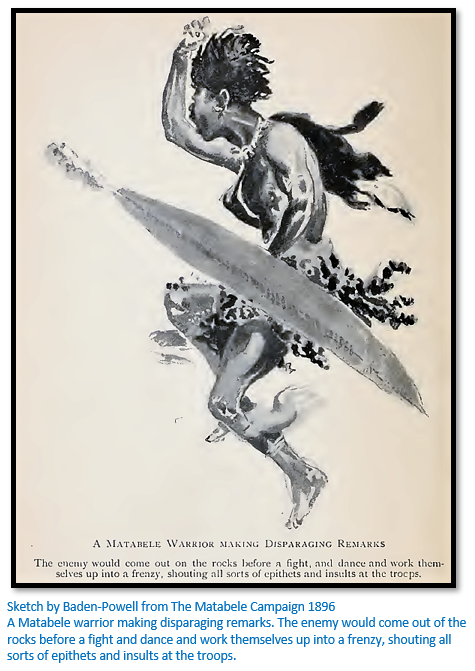
‘B-P’ wrote a series of campfire yarns in his classic book Scouting for Boys – No 17 was entitled ‘Folk dancing from the Matopos’ and he wrote. “When I was a fairly active young bounder I went in for skirt dancing. It amused people at our regimental theatricals and it was a good exercise for me. But I came to realize a new value in it later on when I had to carry out some scouting on service against the Matabele in South Africa. I had climbed into their mountain fastnesses in the Matopo Hills and was discovered by them. I had to run for it. Their great aim was to catch me alive as they wanted to give me something more special in the execution line than a mere shot through the head; they had some form of unpleasant torture in line for me. So when I ran, I ran heartily. The mountain consisted largely of huge granite boulders piled one on another. My running consisted largely in leaping down from one boulder to another and then it was that balance and foot management gained in folk dancing came to my aid. As I skipped down the mountain I found myself out-distancing my pursuers with the greatest of ease. These, being plains men, did not understand rock-trotting and were laboriously slithering down the boulders after me. So I got away and with the confidence this engendered, I paid many successful visits to the mountains after this.”
The Scout hat
The story goes that soon after ‘B-P’ arrived in Bulawayo he visited a shop called Beasley’s to replace his military headgear with a ‘Boss of the Plains’ stetson and rather than denting the hat in the middle as was the custom, he poked four fingers into the crown. The hat became his trademark and later part of the official Scout uniform.
The Kudu Horn
The story goes that ‘B-P’ whilst on patrol was puzzled at how quickly alarm was spread among the amaNdebele and found that the Kudu horn was being blown to warn warriors as soon as European troops were sighted. The deep note of a Kudu horn carried a coded signal over a long distance and ‘B-P’ took one of these horns home with him as trophy. The Kudu horn has long been a symbol of Scouting and of the Wood Badge since it was used to summons the very first scouts at Brownsea Island in 1907 and the Kudu Horn or a substitute is used in all U.S. Wood Badge Courses.
Scouts scarves
‘B-P’ states in Matabeleland Campaign that the Scouts scarves started life in Matabeleland as “a grey-coloured handkerchief loosely tied around the neck to prevent sunburn and can be tightened up at night as a comforter.”
Gordon Park Scout Campsite, Matobo, Bulawayo
Situated within Matobo National Park this marvellous facility hosts the Boy Scouts Association of Zimbabwe Matabeleland Province and has provided life-time skills to young men since 1909 and is a great tribute to the founder Robert Baden-Powell. Visit the excellent website http://www.matabele.altervista.org
Epilogue
Jeal states that Burnham and ‘B-P’ knew that they were themselves in the process of destroying the warrior society they so much admired. They consoled themselves they were instilling in young adults the ‘tribal virtues’ and self-reliance of the American Indians and amaNdebele - bravery, endurance and skill in woodcraft which would counteract the inertia of modern city life. He admired the team spirit shown by the men in Matabeleland who did their best “not because they are well ordered to” as one trooper expressed it, but “because it is the game.”
Book written by B-P
| 1883 | On Vedette | 1916 | Young Knights of the Empire |
| 1885 | Reconnaissance and Scouting | The Wolf Cub's Handbook | |
| 1885 | Cavalry Instruction | 1918 | Girl Guiding |
| 1889 | Pigsticking or Hoghunting | 1919 | Aids to Scoutmastership |
| 1896 | The Downfall of Prempeh | 1921 | What Scouts can do |
| 1897 | The Matabele Campaign | An Old Wolf's Favourites | |
| 1899 | Aids to Scouting for NCO's and men | 1922 | Rovering to Success |
| 1900 | Sport in War | 1927 | Life's Snags and How to Meet Them |
| 1901 | Notes and Instructions for the South African Constabulary | 1929 | Scouting and Youth Movements |
| 1907 | Sketches in Mafeing and East Africa | 1933 | Lessons from the Varsity of Life |
| 1908 | Scouting for Boys | 1934 | Adventures and Accidents |
| 1909 | Yarns for Boy Scouts | 1935 | Scouting Round the World |
| 1910 | Scouting Games | 1936 | Adventuring to Manhood |
| 1912 | Handbook for Girl Guides (with Agnes Baden-Powell) | 1937 | African Adventures |
| 1913 | Boy Scouts Beyond the Seas | 1938 | Birds and Beasts of Africa |
| 1914 | Quick Training for War | 1939 | Paddle Your Own Canoe |
| 1915 | Indian Memories | 1940 | More Sketches of Kenya |
| My Adventures as a Spy |
Until 1907 the books cover military subjects; thereafter they are about the Scouting movement
Military life and career of B-P
| Year | Country | |
| 1857 | England | Born London 22 February |
| 1869 | England | Charterhouse school |
| 1876 | India | gazetted sub-lieutenant in 13th Hussars |
| 1878 | India | promoted to lieutenant |
| 1880 | England | attends School of musketry at Hythe in Kent |
| 1881 | Afghanistan | rejoins the 13th Hussars at Kandahar, Afghanistan |
| 1882 | Afghanistan | Adjutant to the 13th Hussars |
| 1883 | England | promoted Captain |
| 1884 | South Africa | Intelligence work in Natal |
| 1887 | South Africa | A.D.C. to his uncle, Lt-Gen Henry Smythe at Cape Town |
| 1888 | South Africa | military secretary and intelligence officer in campaign against Dinizulu. Promoted brevet-Major |
| 1889 | South Africa | Secretary to Swaziland Commission |
| 1890 | Malta | Major and A.D.C. to his uncle, Lt-Gen Henry Smythe in Malta |
| 1891 | Malta | Intelligence officer in Mediterranean countries |
| 1893 | Ireland | rejoins the 13th Hussars |
| 1894 | England | Manoeuvres in England, Brigade-Major to General French |
| 1895 | Ashanti | Command of native levy against Prempeh, promoted brevet-Lt-Col. |
| 1896 | Rhodesia | Matabeleland campaign. Lt-Col and Chief Staff Officer to Matabeleland Relied Force |
| 1896 | Rhodesia | Lt-Col and Chief of Staff to Matabeleland Relied Force. Published Downfall of Prempeh |
| 1897 | India | Brevet-Colonel and command of 5th Dragoon Guards. Published The Matabele Campaign |
| 1898 | India | Acting Major-General |
| 1899 | Rhodesia / Bechuanaland | Special Service Officer in command of Rhodesia / Bechuanaland Regiments. Siege of Mafeking. Published Aids to Scouting |
| 1900 | Bechuanaland | Mafeking relieved. Promoted Major-General, Western Transvaal command, raised South African Constabulary |
| 1903 | England | Inspector -General of Cavalry England and Ireland |
| 1907 | England | Published Sketches in Mafeking and East Africa. Scouting camp at Brownsea Island |
| 1908 | England | Command of Territorial Division. Published Scouting for Boys and starts The Scout |
| 1909 | England | Boy Scout rallys at Crystal Palace and Glasgow. KCB and KCVO |
| 1910 | England | resigned Territorial command and from army |
| 1911 | England | Scouting movement |
| 1912 | England | Married Olave St Claire Soames |
| 1914 | England | Published Quick Training for War, Indian Memories, Memories of a Spy; visited British army in France |
| 1919 | England | Published Aids to Scoutmastership |
| 1920 | England | Olympia International Jamboree, International Scout Bureau founded |
| 1922 | England | Published Rovering to Success |
| 1924 | England | International Jamboree at Wembley |
| 1929 | England | presented with a Peerage |
| 1933 | England | Published Lessons from the 'Varsity of Life |
| 1937 | England | Order of Merit, retired from the Scouting and Girl Guiding movements |
| 1939 | Kenya | Moved to Nyeri, Kenya |
| 1941 | Kenya | Died on 8 January and buried at St Peter's cemetery in Nyeri |
| Amended from R.H. Kiernan | ||
References
E.A. H. Alderson. With the Mounted Infantry and the Mashonaland Field Force. Books of Rhodesia, Bulawayo 1971
R.S.S. Baden-Powell. The Matabele Campaign 1896. Methuen and Co, 1901
R.S.S. Baden-Powell. Scouting for Boys. Oxford University Press, 1908
F.R. Burnham. Scouting on Two Continents. Books of Rhodesia, Bulawayo 1975
C.E. Callwell. Small Wars. Their Principles and Practice. His Majesty’s Stationery Office, 1899
T. Jeal. Baden-Powell. Hutchinson, 1989
R.H. Kiernan. Baden-Powell. George G. Harrap & Co, London 1939
Pinetreeweb.com/bp-matabele-campaign-00.html
The ’96 Rebellions, BSAC Reports. Books of Rhodesia. Bulawayo, 1975
T.O. Ranger. Revolt in Southern Rhodesia 1896-7. Heinemann 1979
R.S. Roberts. Major General Sir Frederick Carrington and his daughter Dorothy. An Imperial Frontiersman and a Transient on the Frontier of Settlement. Heritage of Zimbabwe, No 33, 2014
F. Sykes. With Plumer in Matabeleland. Books of Rhodesia No 21. Bulawayo, 1972

